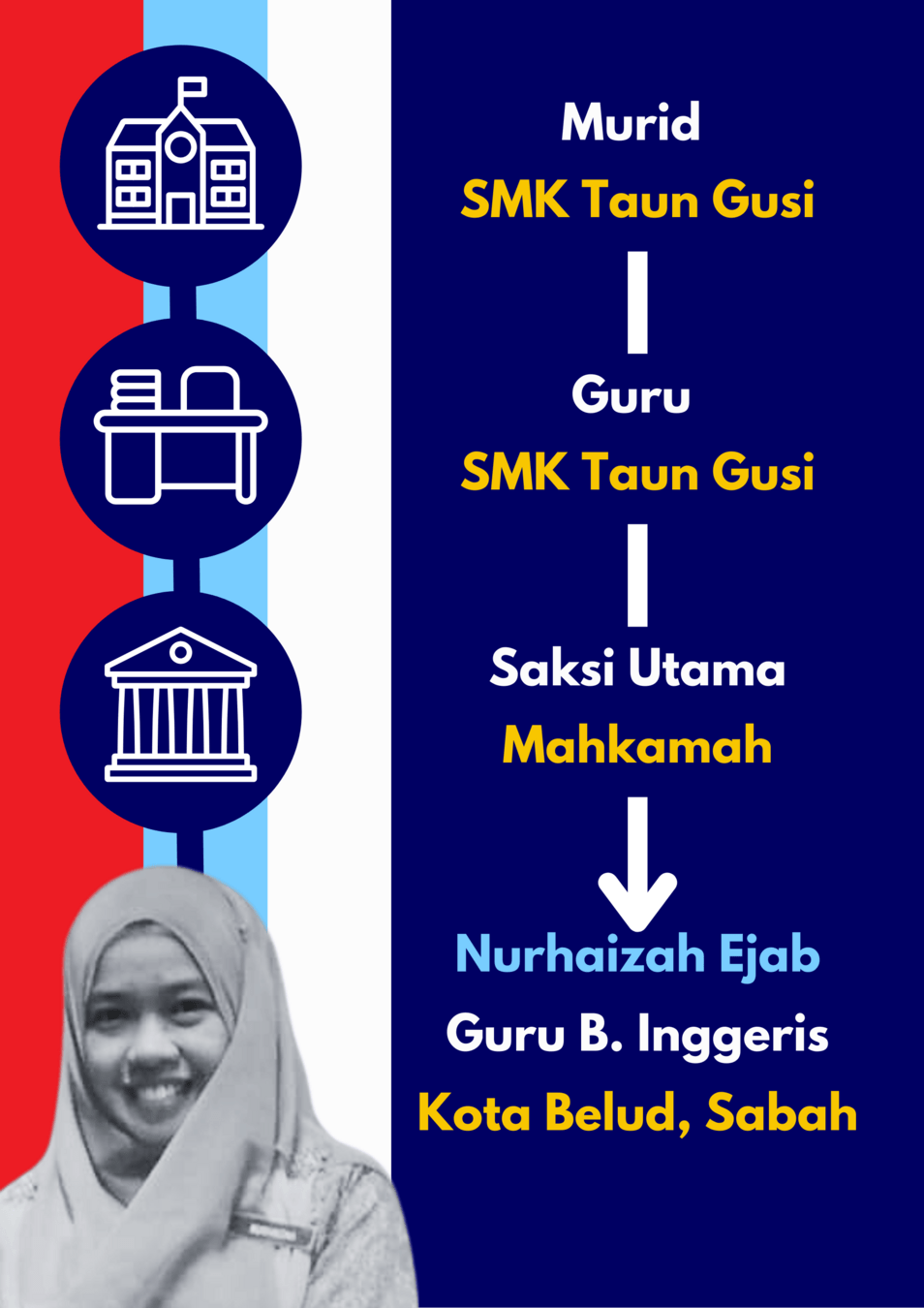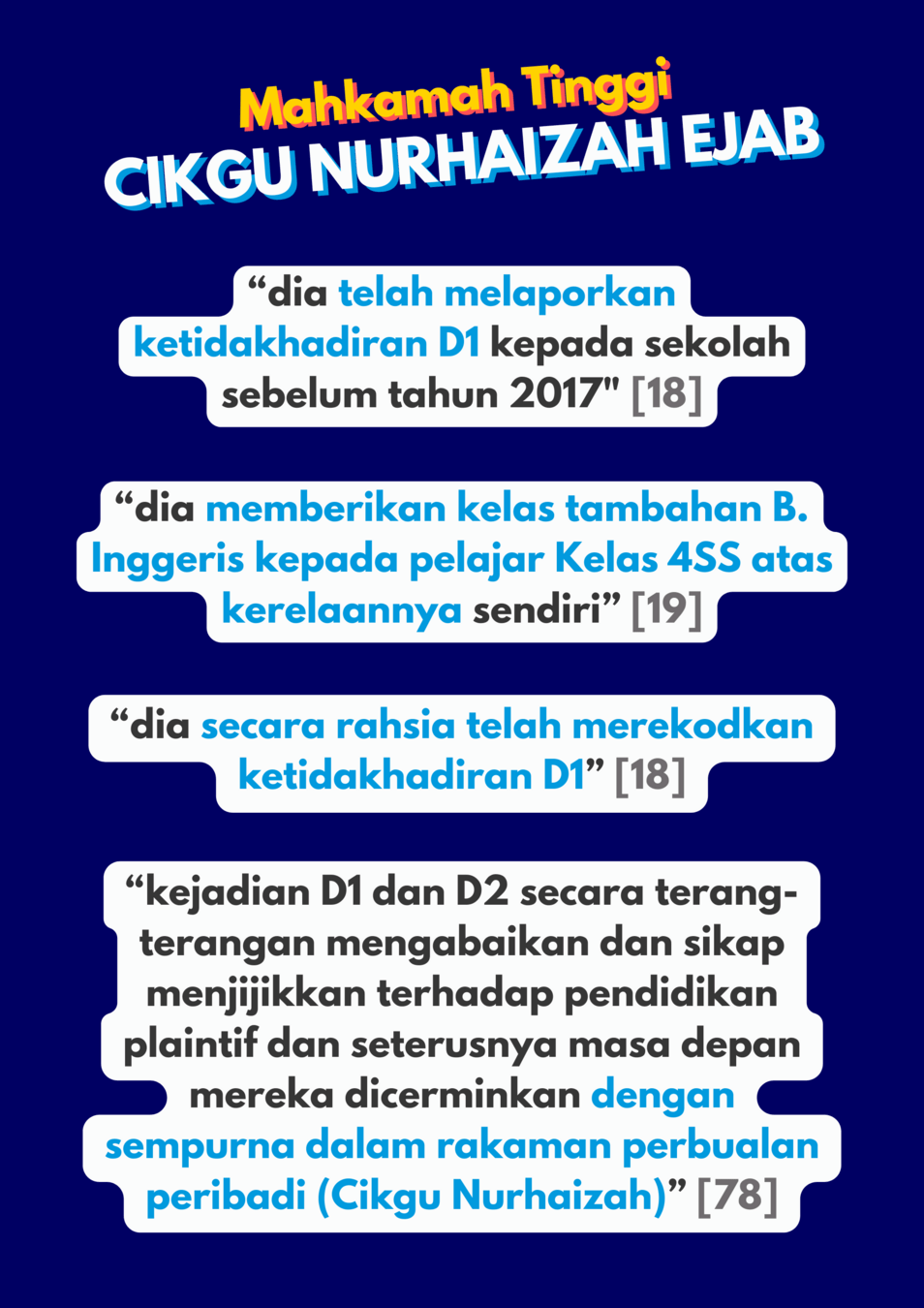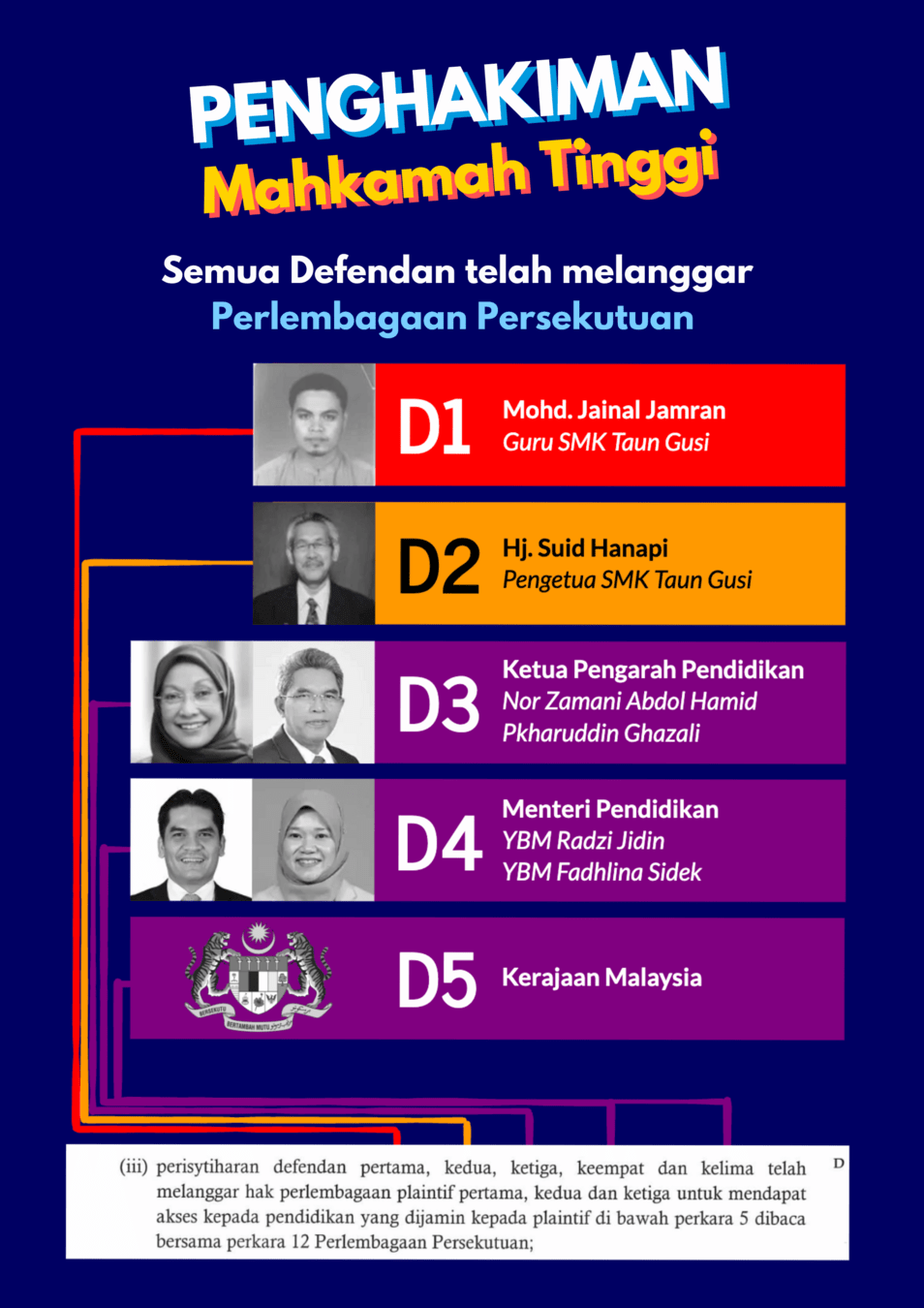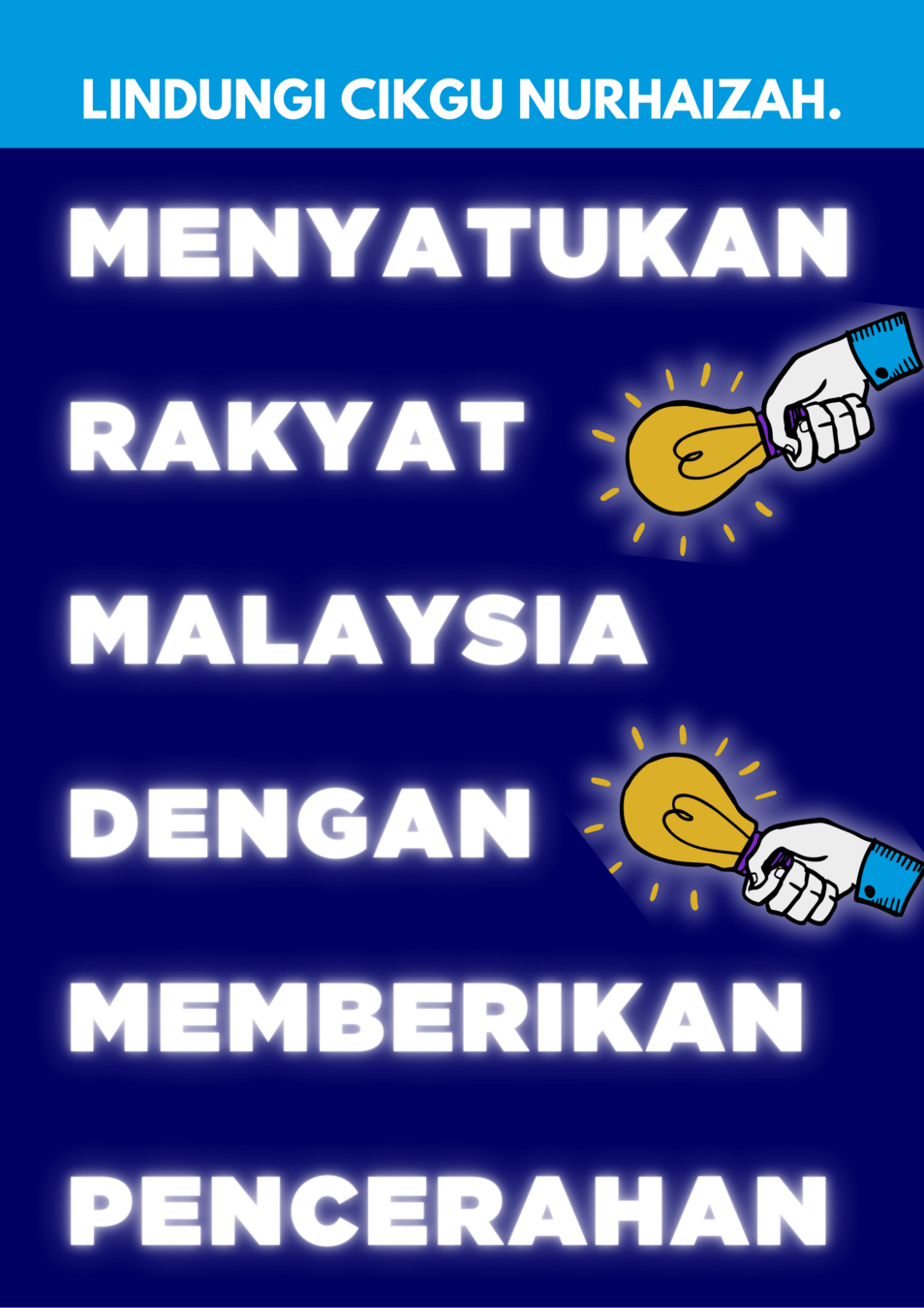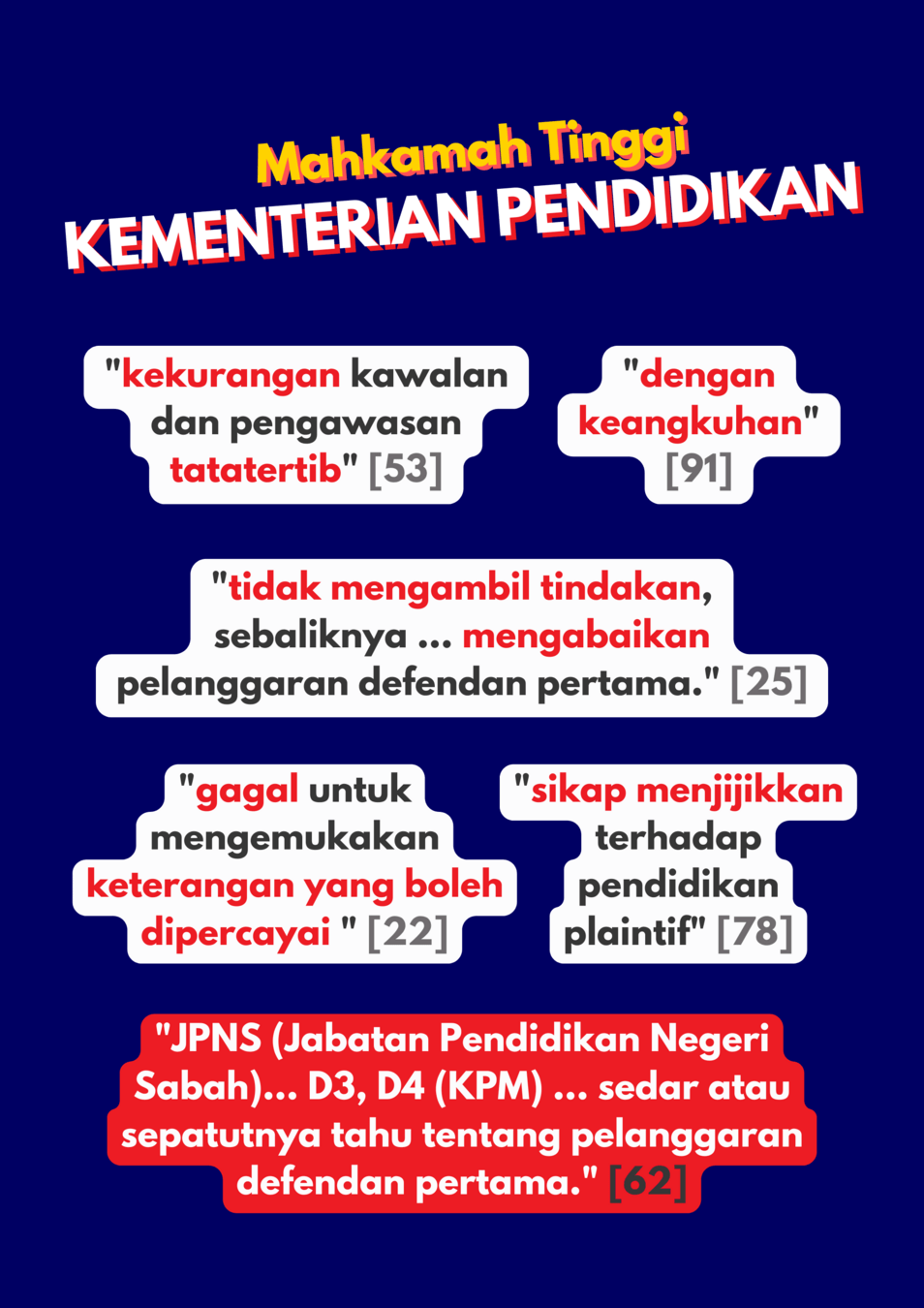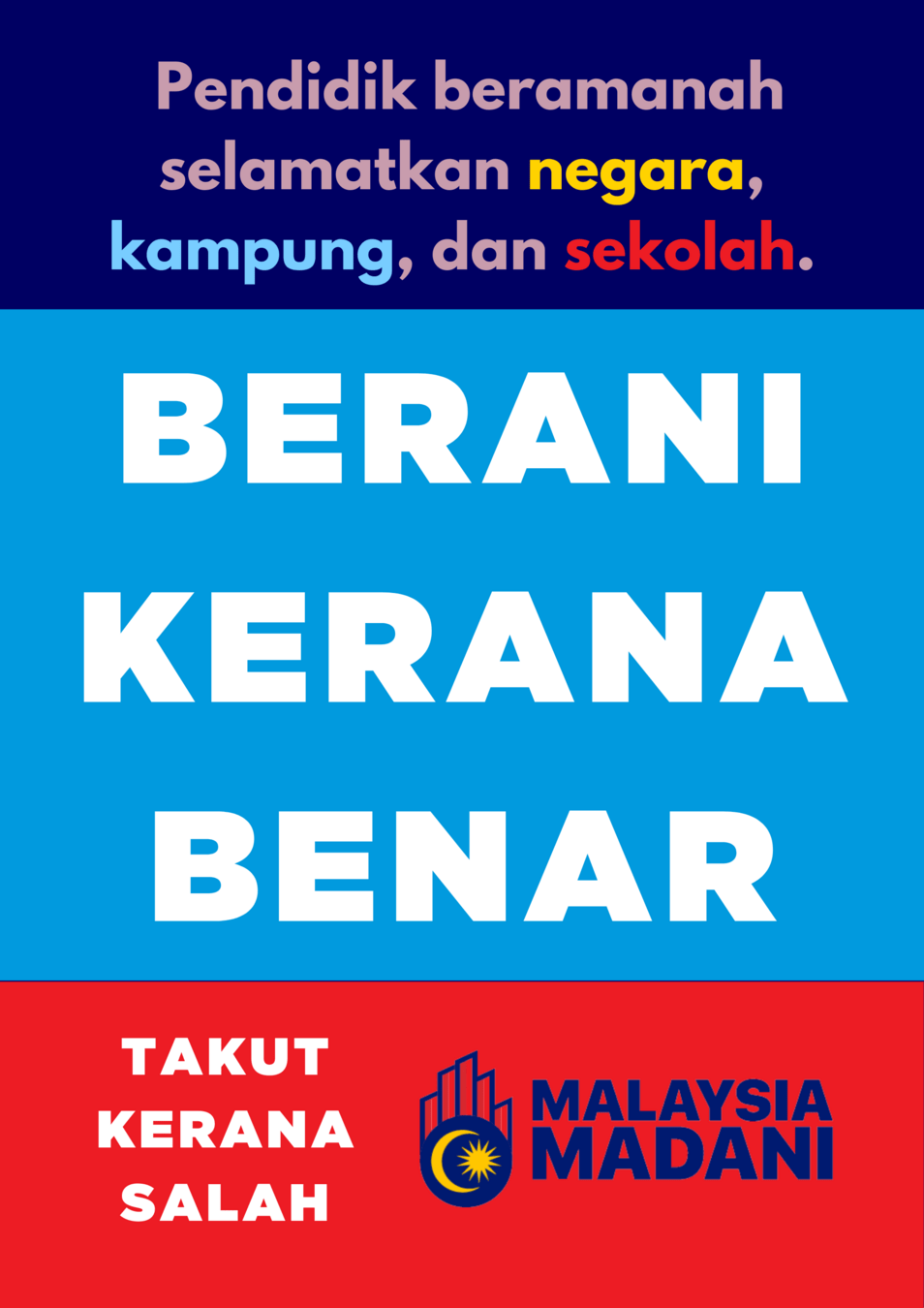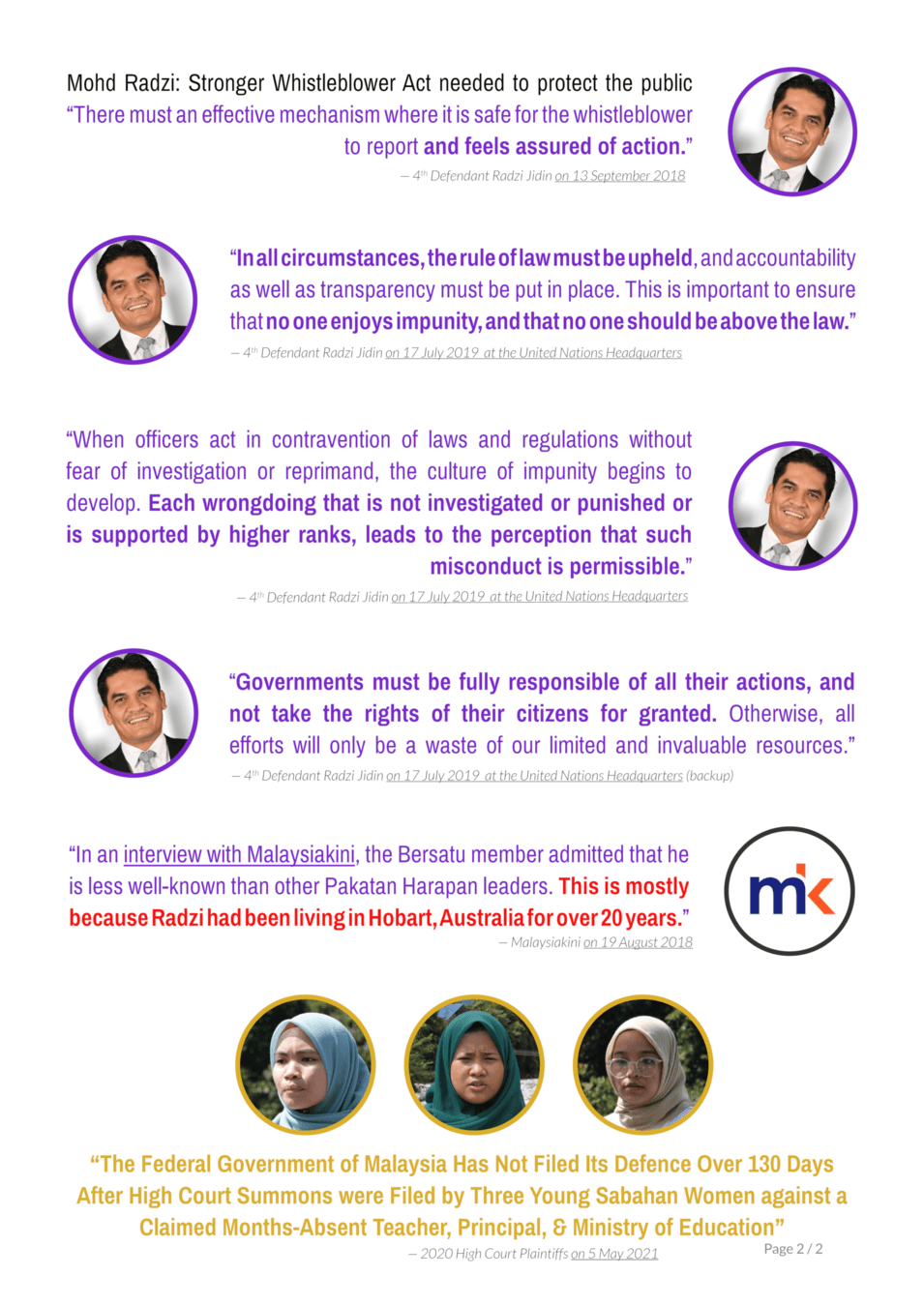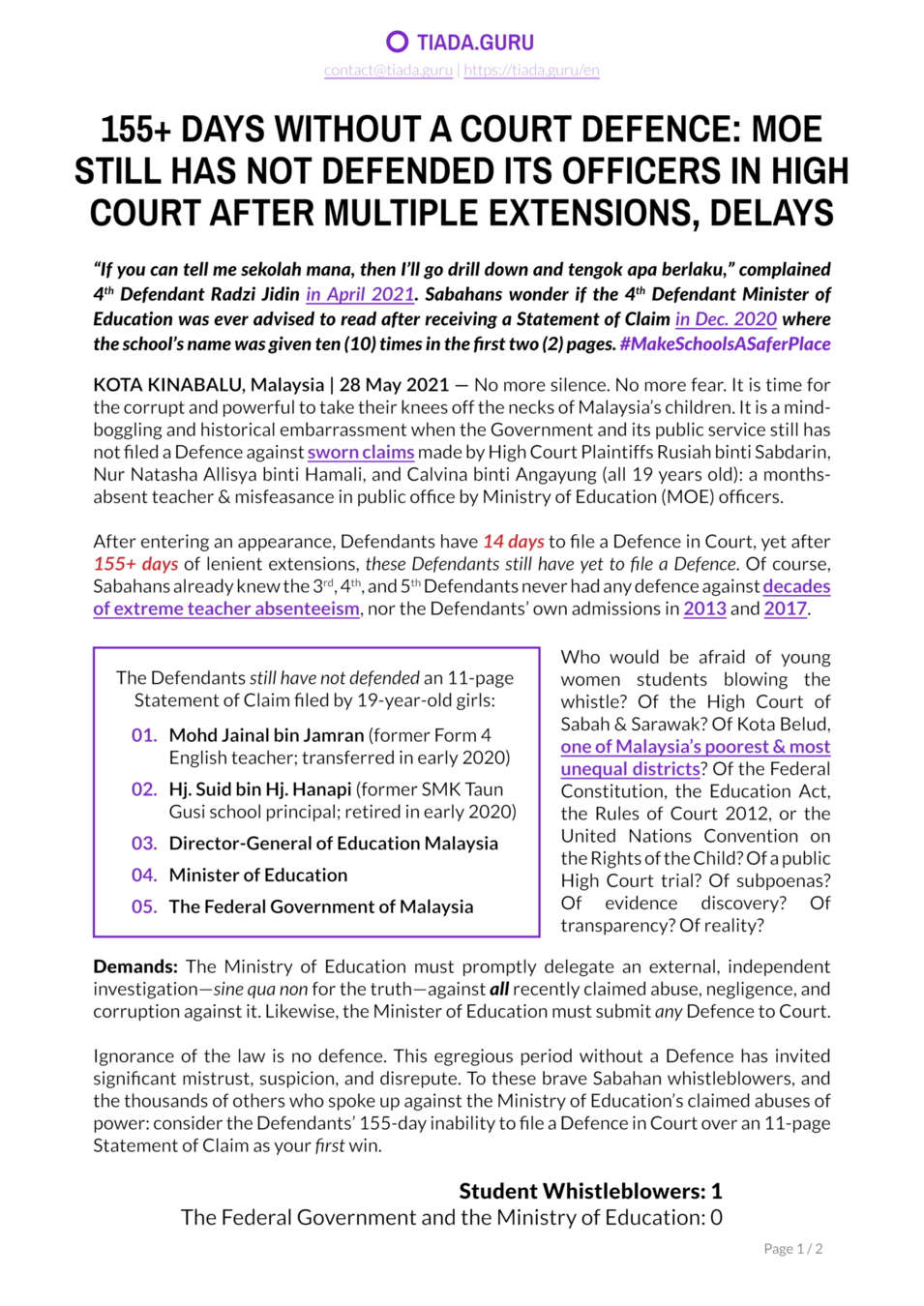THE 2020 HIGH COURT JUDGMENT
Scroll ➡️ to continue the story
Scroll ⬇️ to go deeper
Rakyat bangkit untuk pendidikan bersih.
Malaysians have stood up for clean education.





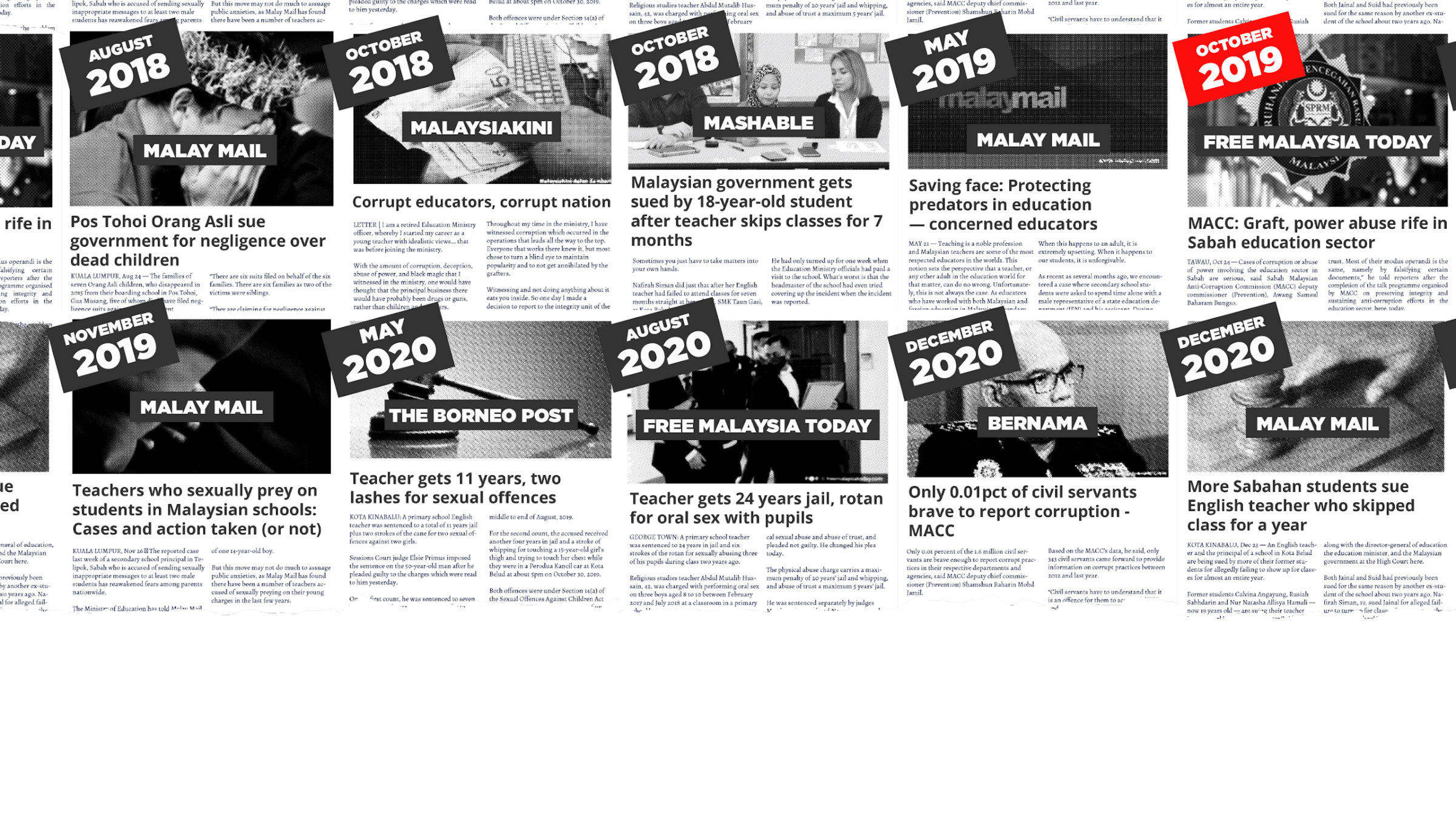
Tiada.Guru MOE teachers have blown the whistle for combined decades to enforcement agencies, MOE Integrity Unit officers, JPNs, PPDs, principals, and parents.
We are the minority. Most cases are never reported by anyone.
Website: tiada.guru | Email: contact@tiada.guru



How it started
December 2020




Where did this story begin?




Kota Belud
Kota Kinabalu
Kota Marudu
Mount
Kinabalu


Kudat
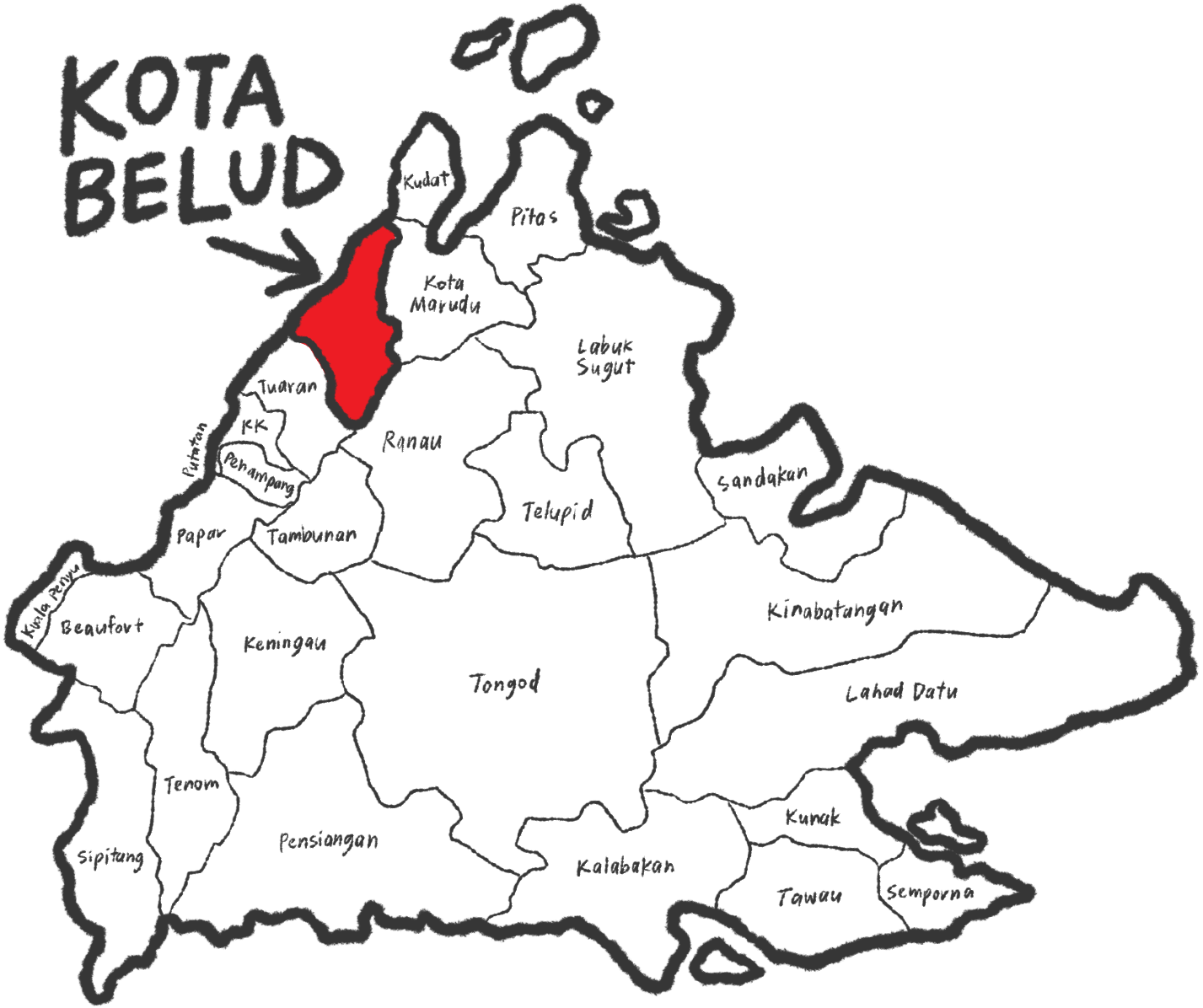






SMK Taun Gusi, Jalan Kudat, 89150 Kota Belud, Sabah, Malaysia
SMK Taun Gusi "Semtasi"

Few in our history have been raised with so little, yet fought so compassionately as these three High Court Plaintiffs:
- Calvina Angayung: a fisherman’s daughter; her family survived years without electric supply.
- Rusiah Sabdarin: a chicken farmer’s daughter; her family nearly beat her after she refused to withdraw her litigation.
- Nur Natasha Allisya Hamali: an ex-police officer’s daughter; forced by her extended family to drop her future studies after she refused to withdraw her litigation.

How it ended
July & August 2023
Preview
How High Court described the AGC-MOE and its witnesses
| “flagrant disregard” [78] | “unprofessional conduct” [49] |
| “abhorrent attitude” [78] | “psychological trauma” [93] |
| “humiliating” [92] | “breach of statutory duty” [49, 55, 77] |
| “unfair” [49] | “no credible evidence” [21] |
| “high-handed” [91] | “breach of the Education Act” [95] |
| “leaked questions” [43] | “knew about DW1’s absences” [26, 31] |
| “indiscretions” [44] | “violated…the Constitution” [95] |
| “despite knowing” [47] | “lack of supervision” [53] |
| “emotional injury” [53] | “failed to…refute recording” [34] |
| “hardship, loss” [54] | “never refuted by DW2” [45] |
| “negligence” [55, 57, 63] | “strict liability on the offender” [76] |
| “breach of confidential information” [49] |
| “shift all blame from the absent teacher to the students” [92] |
| “DW1…did not produce…any…documentary evidence” [20] |
| “Instead of taking action…ignore…transgressions” [25] |
| “failure…to produce…not been satisfactorily explained” [21] |
| “does not find him [DW1] to be a credible witness” [22] |
| “failed to adduce credible evidence to prove otherwise” [22] |
| “clear and unequivocal admission of his absences” [17] |
| “no evidence…Defendants…made genuine attempts” [21] |
| “was notified of the first defendant’s absenteeism” [92] |
| “JPNS... D3, D4 ... were aware or ought to have known” [62] |
Read like a lawyer
🧑💼 advocate & solicitor
The formal term for a lawyer or legal counsel. Importantly, they do not merely represent their clients: first and foremost, they are Officers of the Court.
🧑🏫 officer of the court
The most basic and overarching role for all advocates and solicitors in both private and public service. As Officers of the Court, their sworn responsibilities are to 1) assist the Court (e.g., the Judge) in its fact-finding mission and 2) represent their clients to ensure they are not unjustly treated during the litigation process.
🗡️ statement of claim | written by the plaintiffs
The formal term for a Plaintiffs' pleadings. In this document, the Plaintiffs state their legal claims, laws violated, and remedies requested from Court. Here, the Plaintiffs are Rusiah, Nur Natasha, and Calvina, which are represented by Sherzali Asli of Asli & Cham Chambers. The Judgment rules on only these formal claims in this document.
🛡️ statement of defence | written by the defendants
The formal term for the Defendants’ pleadings. In this document, the Defendants admit to any part of Plaintiffs’ Statement of Claim and defend the rest. The Defendants must make specific responses to each claim. Here, the Defendants are the teacher, principal, and MOE, all represented by the Attorney General’s Chambers (AGC). The AGC is assisted by the MOE’s Legal Unit to conduct a legal investigation, e.g., gather evidence.
💼 evidence bundle
Before trial begins, each party must share with the other party & the court their exhaustive evidence to prove their pleadings. The bundle may include documents, transcripts, audio, images, videos, etc.
An exception are subpoena witnesses who may tender fresh evidence within their testimony.
Read like a lawyer
🙋 witness
A person that knows first-hand information or has evidence about events in the Statement of Claim or Statement of Defence.
The witness' basic and overarching role is to assist the Court in its fact-finding mission: they are not called to "help only one party" or "protect someone".
Each party must call enough and all relevant witnesses to prove their pleadings. Parties may a) call witnesses that choose to testify voluntarily or b) file a Court-ordered subpoena to testify under the penalty of law.
Witnesses testifying voluntarily will submit their evidence early so that their evidence is included in the party's evidence bundle of the party that called them.
Subpoena witnesses appear only later in litigation and thus may submit fresh evidence during their trial testimony.
All testimony is protected from defamation claims, e.g., you cannot be sued only for what you stated in Court.
✍️ notes of proceedings (NOP)
The trial's full transcript, i.e., all witness testimony; all advocate & solicitor's questions, comments, and objections; and all of the Court’s verbal orders.
📜 submissions
Each party's closing arguments, prepared by their advocate & solicitor. It summarizes for the Court all witnesses, adduced evidence, and case law (e.g., case precedent) as a final stand essay on why their side must win.
🧑⚖️⚖️ judgment
The Court’s finding of fact and final conclusion after consideration of both parties’ witnesses, evidence, and submissions. After appeals, it stands as the conclusion on the matter. This Judgment must accept or deny each of the Plaintiffs' claims, in part or in whole. In a civil case like this, a claim is accepted if the claim's evidence & testimony is stronger than the evidence & testimony against it.
Read like a lawyer
👊 injunction
An order by the Court, often pre-trial, for one party to stop doing something. In some cases, it can be a restraining order, e.g., stop party A from contacting or meeting party B before trial.
The legal standard is quite high to obtain a Court injunction, especially against the Government. Significant evidence must be produced to prove that such a protective order is fair, necessary, and refusing this order would allow the offending party to permanently disrupt litigation.
🔝 vicarious liability
A legal principle that a superior is also responsible for their subordinates' conduct. It arises from a superior's responsibility to monitor / prevent / halt / limit their subordinates and any injury they may cause. Malicious intent is not required for vicarious liability to be activated.
📈 examination-in-chief (EIC)
📉 cross-examination (cross)
The second and final half of a witness' testimony in trial. Now, the opposing party's counsel will question this witness on their evidence & their EIC. Cross allows the opposing party to find holes or critical mistakes from the witness' EIC earlier, either in testimony or evidence. Here, the Defendants' AGC Senior Federal Counsel cross-examines the Plaintiffs & their witnesses.
The first half of a witness' testimony in trial. During EICs, witnesses answer questions from the party that called them to 1) explain what they saw; 2) what they did; and 3) any relevant background information the Court may not be aware of. For example: if the Plaintiffs call themselves as witnesses → their counsel will ask the EIC questions. If the Plaintiffs subpoena an MOE officer, the Plaintiffs' counsel will ask the EIC questions to that officer. The EIC can be a pre-written Witness Statement with optionally new questions at trial, or for subpoena witnesses, only new questions at trial.
Read like a lawyer
⚙️ statutory duty
The Government's tasks as required by law. It is the list of actions that a public servant / public body must do or must follow in order to obey the law.
Public servants serve the public by implementing specific laws, regulations, and legal precedents (Judgments made in completed lawsuits). All statutory duties are required by law. "Statutory" means related to a "statute", another word for a "law", e.g., legal duties.
Violation of a public servant's statutory duties is equivalent to a public servant breaking the law.
🧩 structure of the MOE
Schools = lowest level
PPD = Pejabat Pendidikan Daerah or District Education Office
JPN = Jabatan Pendidikan Negeri or State Education Department
KPM = Kementerian Pendidikan Malaysia or Ministry of Education
🛑 adverse inference
If Party A had relevant evidence, but 1) withholds or fails to produce that evidence and then 2) cannot satisfactorily explain why / how their evidence cannot be produced, the Court will presume that evidence was not favorable to Party A. Thus, it is "adverse" (negative) + "inference" (logical, evidenced conclusion). For example, if a principal cannot explain why crucial school documents were mysteriously lost.
🤝 agreed facts
First, both parties simplify by carefully writing a list of agreed facts that they both agree on. By admitting these uncontested facts, it allows the trial—and the judge—to primarily focus and decide on the core disputes, thus...
🙅 agreed issues to be tried
Second, both parties simplify by carefully writing a list of core disputes where both parties disagree. These core disputes summarize the claims & defences into short, factual questions. The Judgement answers each core dispute, e.g., who is right and why.
⬇️ Before a trial begins, both parties sit down to simplify the case that the Court will hear. They simplify with two critical documents: 1) agreed facts and 2) agreed issues to be tried.
Read like a lawyer
🧱 material
Material means "relevant". For example in this litigation, the "material time" of the 1st Defendant's attendance only includes the English periods in the Plaintiffs' classes.
Similarly, immaterial means irrelevant. Thus the 1st Defendant's English period attendance in other classes would be immaterial / irrelevant / not important.
📊 balance of probabilities
What is the threshold for a Judge to agree with a party's claim in a civil proceeding? Simply, the Judge compares 1) the explanation & evidence for the claim vs 2) the explanation & evidence against the claim. The party whose claims' strength is larger than 50% has the Judgment made in their favour. The threshold for a criminal proceeding is far higher.
🎭 credible / not credible
"Credible" means believable or trustworthy; "not credible" is not believable or untrustworthy. Judges often remark on witness' credibility in their Judgment. A witness' credibility can be discerned by a witness' demeanour in testimony, the witness' supporting evidence or lack thereof, and / or the witness' willingness to fully explain key events (e.g., a not credible witness may reply "I do not remember" to far too many questions on events they ought to remember).
🧠 reasonable steps
A successful negligence claim requires the proof that the offending party did not make even reasonable steps to prevent or mitigate the resulting damage.
"Reasonable steps" can be understood as prudent or ordinary acts of an average person. "Reasonable steps" do not require perfection; the standard is simply normal intelligence.
🙅 constitutional rights
The highest and most sacred rights that no Government, not even a Prime Minister, can deny to any citizen. Constitutional violations carry severe legal penalties.
High Court Summons
7 December 2020


"JJ / Mr JJ / Sir JJ"
High Court Summons
7 December 2020
Plaintiffs (Ps) were SMK Taun Gusi Form 4 students in class Sains Sukan (4 SS) in 2017. 1st Defendant English teacher Jainal Jamran (D1) was assigned to teach 4SS English that year. D1 was under the supervision of 2nd Defendant school principal Suid Hanapi (D2).
Both D1 and D2 are supervised by the Director General of the Education Ministry (D3), the Minister of Education (D4) and Federal Government (D5). Because these superior Defendants were aware of D1's and D2's breaches, D3, D4, and D5 are vicariously liable, as well.
Who?
The Ps stated that at SMK Taun Gusi in 2017:
-
D1 did not enter the 4 SS class for English:
- Frequently absent March to July 2017 and was
- Wholly absent August to October 2017.
- D1 did not make up his absences.
- D2 did not give any guru ganti.
- The 4SS class, including the Ps, never received the Form 4 English curriculum.
- Even though they were aware, D2 did not act against D1; further D3, D4, D5 did not act against D1 nor D2.
What?
- Public Officers (Conduct and Discipline) Regulations (POCDR) 1993
- Education Act 1996
- Federal Constitution
- JPA / MOE Panduan Mengurus Pegawai Tidak Hadir Bertugas
Which laws were claimed to be broken?
What do the laws say?
Public Officers (Conduct & Discipline) Regulations 1993



.
Federal Constitution


Kerajaan amat serius dalam menangani kes pegawai tidak hadir bertugas dan satu panduan khusus disediakan bagi memastikan Ketua Jabatan mengambil tindakan kawalan dan pengawasan tatatertib terhadap pegawai bawahannya supaya kes tidak berulang. ... Tindakan awal perlu diambil oleh Ketua Jabatan atau penyelia dengan memantau pegawai bawahan masing-masing dan menegur atau memberi nasihat supaya pegawai sentiasa mematuhi waktu bekerja.
.
Education Act 1996

What do the laws say?
The Plaintiffs (Ps) asked the High Court for five remedies: first, four declarations:
- That D1, D2, D3, D4, and D5 violated the Education Act because 1) they failed to ensure the Ps were taught English and 2) they failed to prepare the Ps for exams.
- That D2 violated the Public Officers (Conduct and Discipline) Regulations for failing to act against D1.
- That D1 & D2 committed misfeasance in public office.
- That That D1, D2, D3, D4, and D5 violated the Ps' Federal Constitutional rights under Art. 5 & Art. 12.
The Ps also asked for a 5th non-declarative remedy: exemplary, general, and aggravated damages (money).
Remedies
Declarations are Court remedies that recognize rights, e.g., "This party had right A under law B and the other party violated that right with their actions XYZ."
Declarations cannot force any party to act, so they are often preventive: "If the Government's acts XYZ violate someone's legal rights, then the Government will break the law if they continue XYZ in the future."
Here, the Court was asked: is unmitigated extreme teacher absenteeism simply internal MOE misconduct, or is it also a violation of legal & Constitutional rights of students?
What are declarations?
The Plaintiffs' Remedies
7 December 2020
High Court Summons
7 December 2020

D1
D2
D3
D4
D5
P1
P2
P3

Honourable High Court Judge
Justice Leonard David Shim
- Bachelor of Laws (LL.B) (Hons) - University of London (1986 - 1989)
- Called to the Bar of England and Wales at Middle Temple (1991)
- Admitted as an advocate and solicitor - High Court of Borneo (1992)
- President - Advocates Association of Sarawak (2014 - 2016)
- Chief Judge - High Court of Kota Kinabalu (2019 - 2022)
- Judge - High Court of Kota Kinabalu (2022 - 2023)
- Judge - High Court of Kuching, Sarawak (2023 - present)
The Plaintiffs' Announcement
22 December 2020
"This culture continues headstrong, with little consequences from the nation’s principals and the Ministry of Education. ... Why would a principal protect a teacher who refused to teach?"
— NUR NATASHA, 2nd Plaintiff
"What my class experienced is gut-wrenchingly heartbreaking for both of my parents: their sacrifices of energy, money, and time were wasted by the teacher who left us for months without a teacher in the classroom."
— CALVINA, 3rd Plaintiff
"We hope that for other students who are experiencing similar cases: stand up. Dare yourself to fight for our educational rights. Do not let their terrorizing tactics overwhelm you. Together, we will uphold education for future generations."
— RUSIAH, 1st Plaintiff

CALVINA was the Head School Prefect at SMK Taun Gusi.

RUSIAH was the 4 SS Class Monitor at SMK Taun Gusi.

NUR NATASHA was a School Prefect at SMK Taun Gusi.
After officially accepting a Summons, Defendants have 14 days to file a Defence under the Rules of Court 2012 (O. 18 r. 2). But in this case, the AGC-MOE failed to file a Defence for 170+ days, requesting extension after extension until 22 June 2021.
What happened
Disturbing AGC-MOE Delays
22 June 2021
This AGC-MOE Defence delay alone consumed 18% of the total litigation time.
The then-Minister of Education Radzi Jidin claimed to media re: the period spot check scandal: "If you can tell me sekolah mana, then I'll go drill down and tengok apa berlaku." The Plaintiffs' school was mentioned ten (10x) times in the first two pages of their High Court summons.
Why it matters

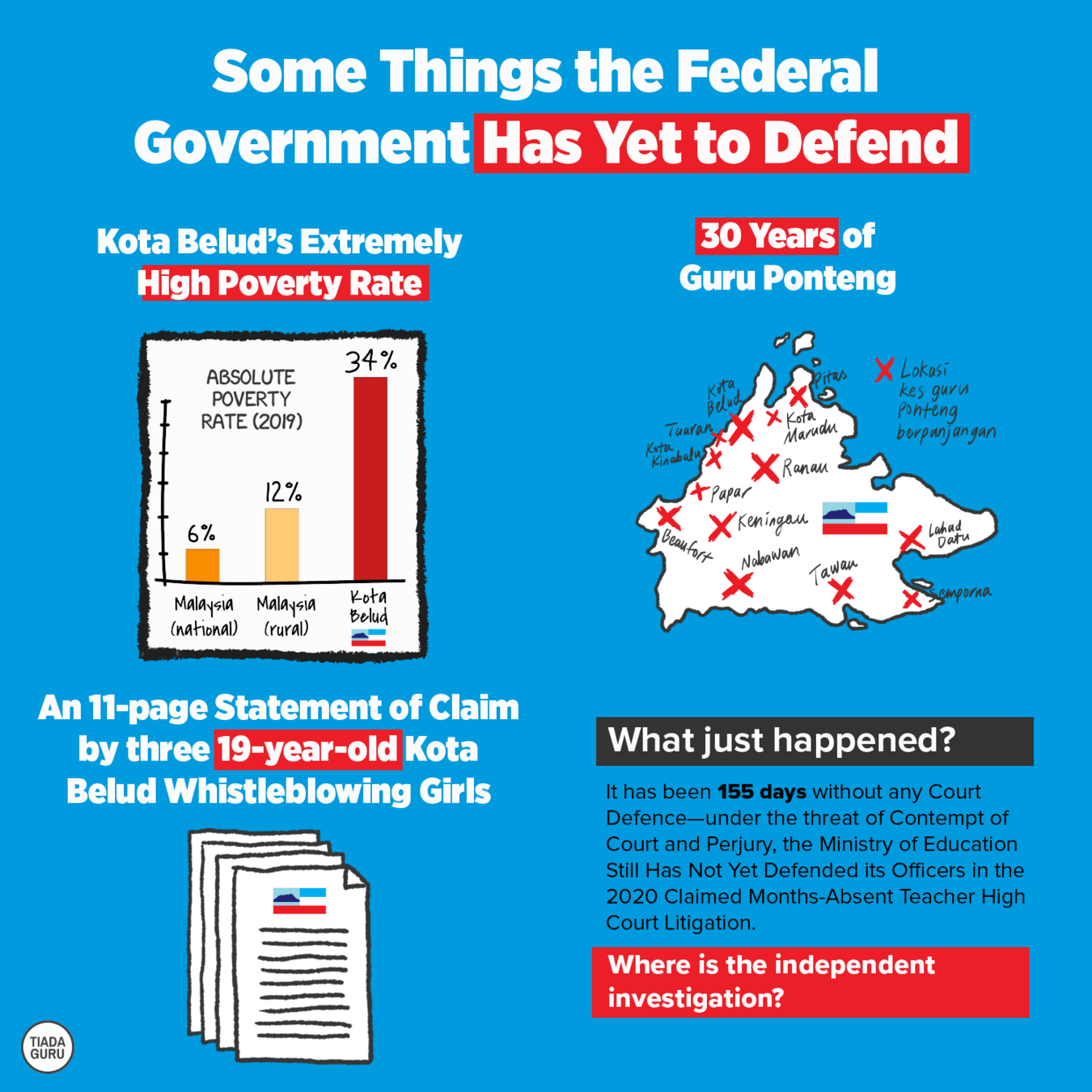
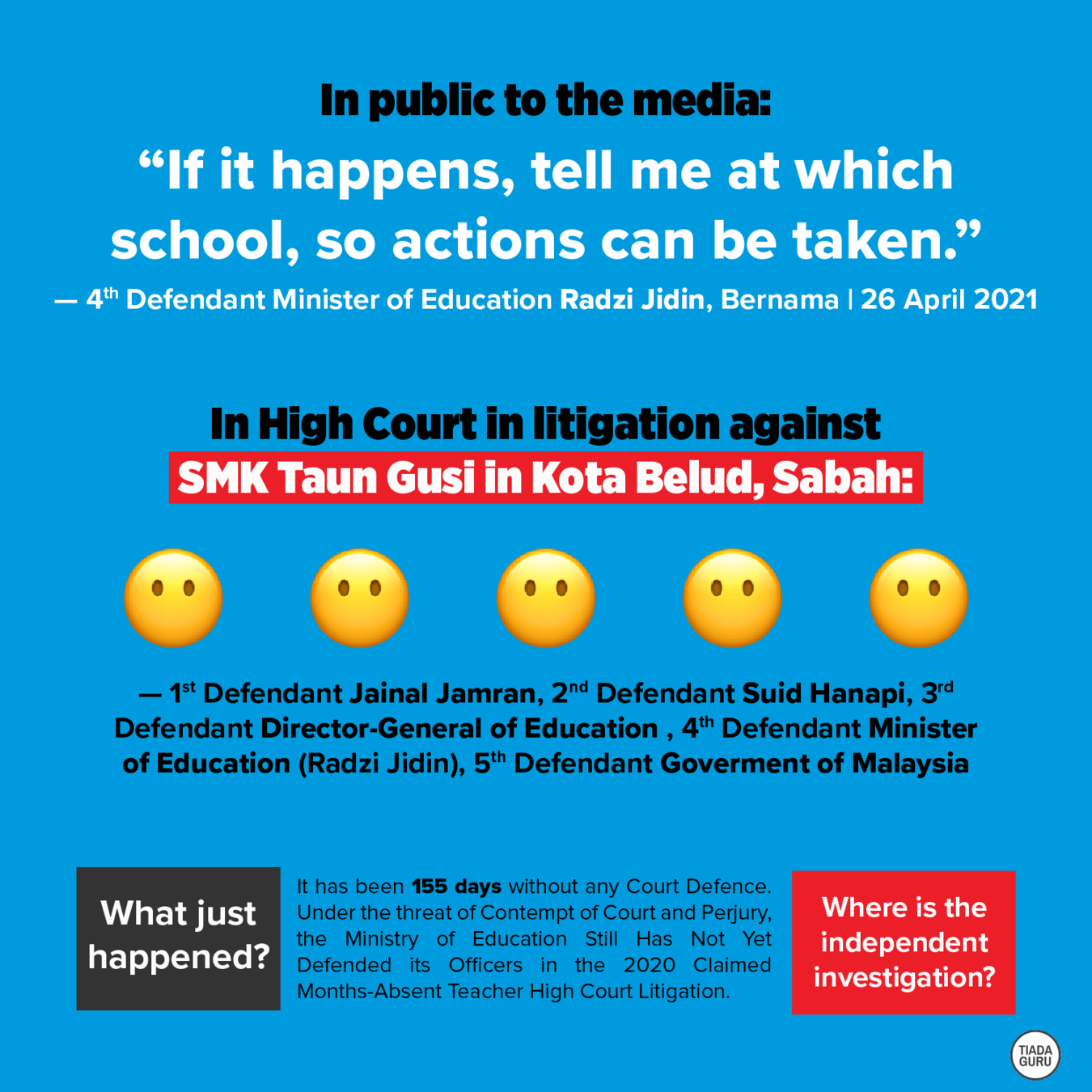
"
"
It is a mind-boggling and historical embarrassment when the Government and its public service still has not filed a Defence against sworn claims made by High Court Plaintiffs Rusiah binti Sabdarin, Nur Natasha Allisya binti Hamali, and Calvina binti Angayung (all 19 years old): a months-absent teacher & misfeasance in public office by Ministry of Education (MOE) officers.
Ignorance of the law is no defence. This egregious period without a Defence has invited significant mistrust, suspicion, and disrepute. To these brave Sabahan whistleblowers, and the thousands of others who spoke up against the Ministry of Education’s claimed abuses of power: consider the Defendants’ 155-day inability to file a Defence in Court over an 11-page Statement of Claim as your first win.
No more silence. No more fear. It is time for the corrupt and powerful to take their knees off the necks of Malaysia’s children.
Campaign Statement
22 June 2021
Who would be afraid of young women students blowing the whistle?
Afraid of the High Court of Sabah & Sarawak?
Of a public High Court trial?
Of subpoenas?
Of evidence discovery?
Of transparency?
Of reality?
Demands: The Ministry of Education must promptly delegate an external, independent investigation—sine qua non for the truth—against all recently claimed abuse, negligence, and corruption against it. Likewise, the Minister of Education must submit any Defence to Court.
From Jan. to Mar. 2021—just weeks after the lawsuit—the MOE's officers in Kota Belud harassed and threatened the Plaintiffs and their families. This MOE interference was at the same time as the AGC-MOE delayed their Defence by months. The Plaintiffs filed for a High Court injunction to restrain the Defendants on 22 June 2021.
What happened
Historic Injunction vs MOE
22 January 2021 → 30 August 2021
How they proved it
One example: on 22 January 2021, SMK Taun Gusi principal Nuzie Balus called Plaintiff Rusiah to a closed-door meeting, where he and three male teachers threatened her. Critically, Rusiah planted an undercover audio recording device and captured it all. On 30 August 2021, the High Court ordered an historic restraining injunction against the D4 Education Minister, D3 Director General of Education, D2 Suid Hanapi, and D1 Jainal Jamran.
STAGE 3: HIGH COURT INJUNCTION








Victims
Ministry of Education
STAGE 1: BEFORE THE SUMMONS








Victims
STAGE 2: AFTER THE SUMMONS
High Court Judge







MOE threats
MOE witness interference
Plaintiffs
Plaintiffs
High Court Judge

MOE Minister, MOE DG, Suid Hanapi, Jainal Jamran
- Rusiah Sabdarin, 21, a former secondary student of SMK Taun Gusi, Kota Belud, said a day after she filed the suit, her father was called by the new principal Nuzie Balus. She was at her uncle’s place in Kinarut then.
- She said in the witness statement that she did not know about the matter until her father came to Kinarut and asked her to withdraw the suit. She told her father she would not, which later caused her brother to almost hit her with a wood. According to Rusiah, after returning to Kota Belud, the relationship between her, her brother and father became a bit cold, but has improved.
- She further said Nuzie also called her to his office and threatened that he has power to take disciplinary action against her and to bring up her school absences that happened years ago.
- Rusiah also testified that Nuzie inquired whether her house had CCTV which she felt was a threat. She also felt that all the questions by Nuzie at the meeting threatened her and her family’s safety. During the meeting, Rusiah said Nuzie asked if her father knew the real intention she filed the case and suspected that the principal was trying to put pressure on her father.
- She said Nuzie warned her to think carefully about her future and for her family. After the meeting, Rusiah was very worried about the unusual actions of the officers of the defendants and caused her to ask her lawyers at the time to apply from the court to stop such behaviour. Her lawyers duly filed for an injunction against the defendants and their officers not to harass Rusiah, her family and other plaintiffs.
Plaintiff Rusiah exposed it all
Historic Injunction vs MOE
22 January 2021 → 30 August 2021
This historic High Court injunction lasted nearly two years, from
30 August 2021 (this Order) → 18 July 2023 (Judgement).
First, the Judgment revealed the MOE broke the law in 2017 when it failed to teach English to the 4 SS class. Second, this Injunction revealed the MOE broke the law again in 2020 when those same students spoke up.
Twice already



Mohd. Jainal Jamran
SMK Taun Gusi teacher
Hj. Suid Hanapi
SMK Taun Gusi principal
Minister of Education
YBM Radzi Jidin
YBM Fadhlina Sidek



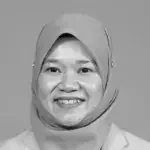

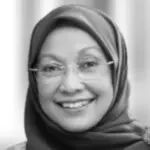
Director General of Education
Nor Zamani Abdol Hamid
Pkharuddin Ghazali
Historic Injunction vs MOE
22 January 2021 → 30 August 2021
The MOE was banned for 20+ months

The High Court ordered D1, D2, D3, and D4 to halt their Court interference against the Plaintiffs. This is one of the first-ever injunctions against a sitting Minister due to their Court interference.
D1
D2
D3
D4
The High Court Trial

| 5 September 2022 | 20 October 2022 | 21 October 2022 |
| 14 November 2022 | 15 November 2022 | 16 November 2022 |
| 23 November 2022 | 10 January 2023 | 11 January 2023 |
High Court Trial Dates
Plaintiffs' Claim vs Defendants' Defence
| 🧕 Plaintiffs' Claims 🧕 | 🏢 Defendants' Defence 🏢 |
|---|---|
| D1 was absent in the 4 SS class 1) frequently between March to July 2017 and 2) wholly absent from August to October 2017. | D1 was "present at all material times during the English classes for 4SS". D1 was not "frequently late or not fully present". |
| D2 did not provide a relief teacher for D1 nor additional classes. The 4 SS class, including the Plaintiffs, never received the Form 4 English Curriculum. | D2 "had taken all appropriate and necessary actions on the problems faced at the material time". Further, "there were no infringement of the Plaintiffs" rights. |
| Even though D2 was aware, D2 did not act against D1. Further, D3, D4, and D5 did not act against D1 nor D2. | All "Defendants had taken all appropriate and necessary actions on the problems faced at the material time." |
Agreed Facts (AF)
March 2022
Agreed Issues to be Tried
2023
AF 1 & 2 | The Ps were registered students of SMK Taun Gusi and entered it F1 (Jan. 2014) to F5 (Dec. 2018).
AF 3 | The Ps were in Form 4 Sains Sukan (4SS) in 2017.
AF 4 | D1, D2, D3, and D4 are employees and/or servants and/or agents of D5.
AF 5 | D1 was assigned to the Ps' Form 4 Sains Sukan (4SS) in 2017 to teach English.
AF 6 | Sometime in May 2017, D2 was notified of D1's absenteeism.
Q1 | Did D1 fail to consistently teach 4 SS English in 2017 (Ps' class), thus failing to prepare the Ps for English exams?
Q2 | If Q1 is true, did D2 have notice of D1's failures?
Q3 | If Q2 is true, did D2 take reasonable disciplinary & supervisory actions against D1?
Q4 | Are D3, D4, and D5 vicariously liable for D1's & D2's failures?
Q5 | Did D3, D4, and D5 take reasonable steps to safeguard the rights of the Plaintiffs?
Q6 | Did the Ps suffer any damages due to the actions of D1, D2, D4, and D5?
Refresher on the laws & regs.
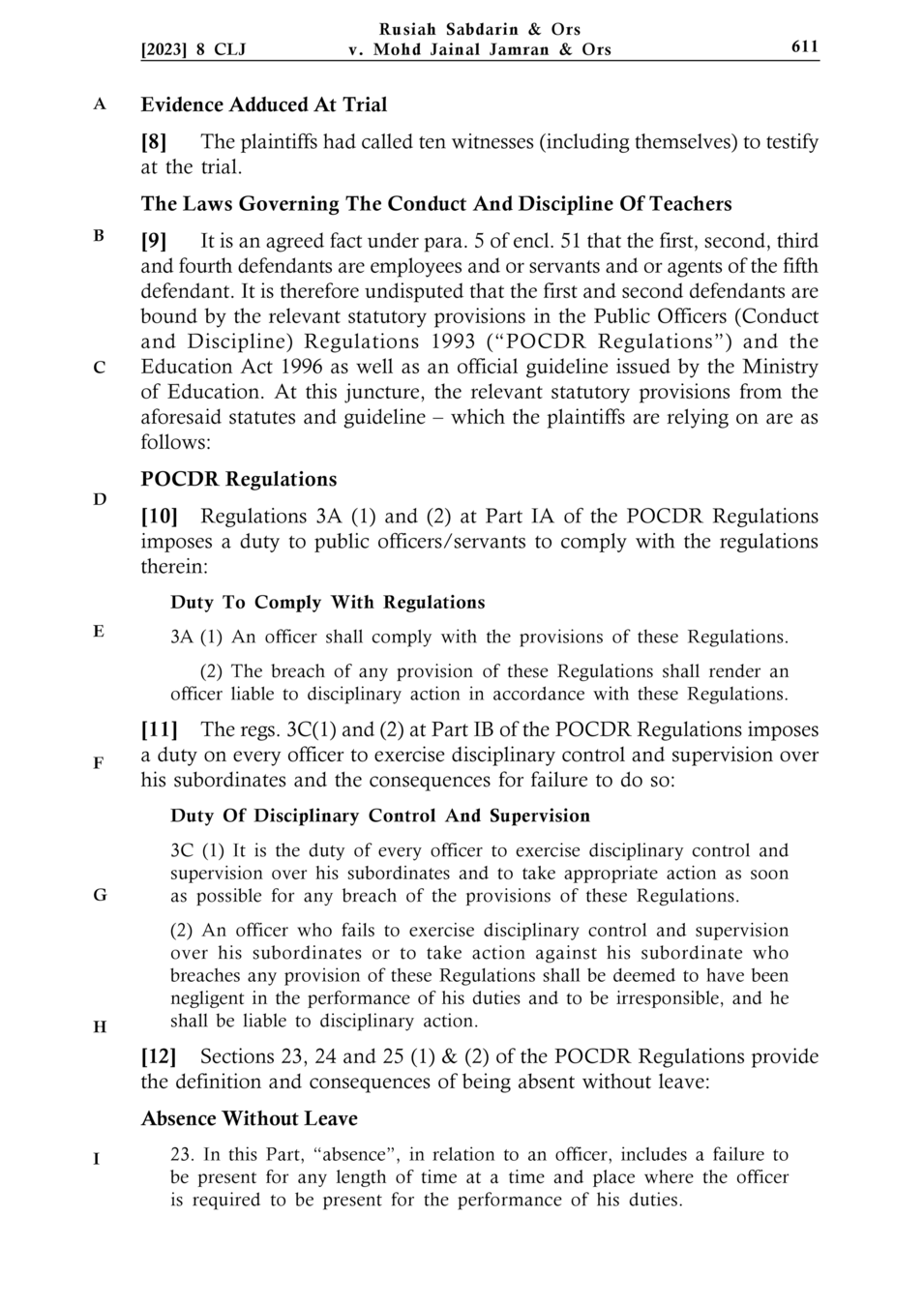
Refresher on the laws & regs.
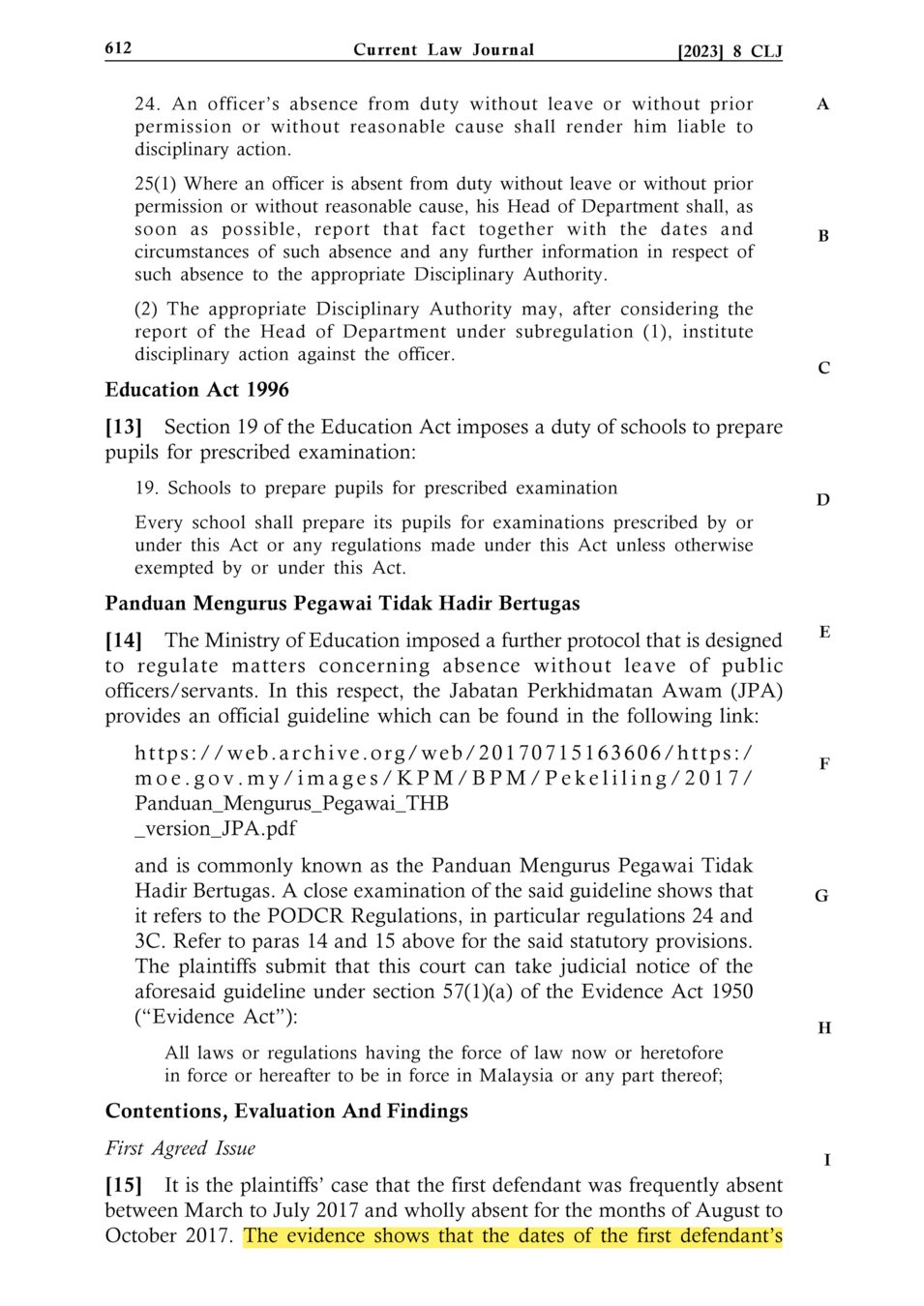

Reference for Trial Quotes
Plaintiffs' Claims
The Ps' Evidence & Testimony
- In his assigned 4 SS English class, D1 was frequently absent March to July 2017 and wholly absent August to October 2017. D1 did not make up his absences nor did D2 provide a guru ganti. Thus the 4SS class, including Ps, never received the Form 4 English curriculum.
- P3 Calvina notified D2 Suid of D1's absences in May 2017. The Ps reported D1's absences to school administrators and teachers.
- D1 never took steps to ensure Ps had exam and English language prep. Further, D1 acted to conceal his absenteeism.
- D2 did not act against D1 nor did D3, D4, D5 act against D1, D2.
- D2, D3, D4, and D5 never took steps to ensure Ps had exam and English language prep, thus D3, D4, and D5 are vicariously liable.
- D1, D2, D3, D4, and D5 violated the Education Act, Public Officers (Conduct & Discipline) Regulations, and Federal Constitution.
-
Plaintiffs' Claims
-
Plaintiffs' Trial Evidence Summary
-
Plaintiffs Call 10 Witnesses
-
Plaintiff Witness Testimony
-
Plaintiffs' Secret Recordings
-
Dr Noor Aishah Rosli: expert
-
Cikgu Nurhaizah ➡️
Table of Contents
Plaintiffs' Trial Evidence Summary
- A pen drive, containing an audio recording of the Hj. Nuzie Balus, the principal of SMK Taun Gusi, when he met Plaintiff Rusiah.
- WhatsApp screenshots from SMK Taun Gusi teachers to the Plaintiffs & other students.
Injunction Evidence
- Analysis of the 2017 1st semester 4SS buku kawalan, by the Plaintiffs.
- A pen drive, containing 11x 2017-era audio-video recordings of D2 Principal Suid Hanapi, PK1 Johari Hajat, Ketua Bidang Bahasa Norhana Idek, PK1 Johari Hajat, Ketua Panitia Bahasa Inggeris Awang Erawan, and students captured by the Plaintiffs.
- SMK Taun Gusi's disciplinary records of the Plaintiffs.
- The buku latihan of multiple 4 SS students.
School Evidence
- Expert child psychologist report, with attachments, on the three Plaintiffs by PW9 Dr Noor Aishah Rosli.
- 80x time-stamped video recordings of the 4 SS classroom during D1's English period; by PW10 Cikgu Nurhaizah Ejab.
- An audio recording of SMK Taun Gusi Teacher Eddy discussing D1 and D2; by PW10 Cikgu Nurhaizah.
Subpoena Witness Evidence
Plaintiffs Call 10 Witnesses
PW = Plaintiff Witness; ex-4 SS student
- PW1 Nurul Afirah Zainal Abidin;
- PW2 Suriana Md Salleh;
- PW3 Rusiah Sabdarin (P1);
- PW4 Mohd Fadzley Izzani Lamsin;
- PW5 Calvina Angayung (P3);
- PW6 Nur Natasha Allisya Hamali (P2);
- PW7 Abdul Shahril Abdul Sahar;
- PW8 Mohd Hafiezzamani;
- PW9 Dr Noor Aishah Rosli (expert witness & child psychologist); &
- PW10 Nurhaizah Ejab (5 SS English teacher).
Sans the Plaintiffs (PW3, PW5, PW6) and Dr Noor Aishah (PW10), all Plaintiffs' witnesses testified under Court Subpoena. While many ex-4SS students were called by the Plaintiffs, one named Norhayati was not as she is a stateless person. The High Court accepted this rationale.
Where was D1? Why didn't he enter?
Plaintiffs' Witness Testimony
- “I remember there was one incident whereby I, together with my classmates, went to call him [D1] to come to our class to teach. But at that time, he told us that he had matters (to attend to) and he did not enter our class,” the witness [PW1 Nurul Afirah] claimed.
- “[PW5] Calvina further testified that she and her friends had tried to call Mr JJ to teach them but he refused.” “In one incident, Mr JJ was allegedly seen at the canteen with another teacher when he was supposed to teach them at the time.”
- “Meanwhile, [PW4] Fadzley testified that he had gone to the teacher’s office to ask him [D1] to enter class."
Where was D1? Why didn't he enter? [continued]
- “She [PW6 Nur Natasha] further said in her witness statement that Mr JJ was allegedly in the office but he did not open the door.”
- “She [PW3 Rusiah] said when the first defendant was missing from class, she found him in his office, but Jainal told her to go to physical education instead.”
- To a question by [FC] Fazrul, [PW6] Nur Natasha said she and her classmates (witnesses) were in the class every time JJ was not in class and [PW3] Rusiah also would record it down.
- “The witness [PW6 Nur Natasha], who is a boutique staff, further stated in her witness statement that she did go to see Mr JJ whenever he did not enter their class or late. However, Mr JJ had asked them to go to do sports activities at the field.”
Which teachers did Ps tell about D1’s absences? What was their teachers' response?
- [PW1] Nurul Afirah also told the court that she and her other classmates had complained about his absence to two other teachers but were advised to “let it be” as they did not want to meddle in [D1] Mr JJ’s affairs.
- “Meanwhile, [PW4] Fadzley testified that he … had also complained to the Art teacher and Bahasa Malaysia teacher over the English teacher’s [D1's] repeated absence.”
- “She [PW2 Suriana] further said she and her friends had complained about [D1] JJ’s absence to their other three teachers but they advised them to study by themselves.”
- “I remember we have complained to Cikgu Shamsul and Cikgu Siti Kamisa; they are our class teacher and our assistant teacher at class 4 Sains Sukan. I remember this when we were talking to them when they were teaching our class. Their answer was similar, they said to just leave the matter be and that they don’t want to be involved in [D1] Mr JJ’s issue,” she [PW1 Nurul Afirah] claimed.
Which teachers did Ps tell about D1’s absences? What was their response?
- “…Suriana Mohammad Salleh [PW2] testified they had complained to their class teacher Siti Khamisa and assistant class teacher identified as Shamsul but were advised to let the matter go.”
- “She [PW2 Suriana] also claimed that together with her classmates, they had raised the issue to the Sports Science teachers such as Cikgu Syamsul, class teacher Siti Kamisa and Visual Art Education teacher, Cikgu Ristommoyo.”
- “When we complained to the teachers, they advised us to study by ourselves. They didn’t help get an alternative teacher for our class,” she [PW2 Suriana] alleged.
What was D1's attitude to his classes?
- “I remember when he [D1] first started teaching he wasn’t very pleasant and was constantly in a foul mood. In other classes he was friendlier,” she [PW1 Nurul Afirah] said.
- “A few months on, we noticed that he [D1] would teach accounting at the class next door, but when it was time for our lesson, he [D1] would not show up,” she [PW1 Nurul Afirah] said.
- “[D1] JJ sometimes entered the class but just for a while. While in the class, he was not friendly and always angry.” “I can compare his behaviour with students in other classes, for example Form Four Prinsip Akaun class which was next to our class. He was friendly with the students,” [PW1] Nurul Afirah shared.
What was the impact of D1’s absences?
- The witness also testified that he [PW4 Mohd Fadzley] failed the English subject because of Jainal’s truancy. “Even though it looks like a simple issue, the impact of such actions are very grave,” he [PW4 Mohd Fadzley] said when testifying in the High Court.
What was the impact of D1’s absences? [continued]
- To which, she [PW1 Nurul Afirah] responded: “The defendant [D1] leaked the exam questions but at the time I didn't know anything because the teacher had not taught us for long. Even if I had answered, I wouldn’t know if I had answered it correctly.”
- She [PW1 Nurul Afirah] alleged that due to the first defendant’s conduct, she felt left behind in her knowledge in the subject. “I also feel there is no direction when it comes to the subject,” she said.
- She [PW2 Suriana] claimed in her witness statement that she initially felt proud of having the first defendant as her teacher but later felt disappointed when he did not teach her class for seven months. Suriana also claimed that she failed in the subject during the final examination at Form 4. According to [PW5] Calvina, she had to move to SMK Narinang to continue her Form Six because she did not want her results to be affected.
- She [PW2 Suriana] added her English subject marks were still poor although the defendant [D1] leaked the exam questions because he “never taught us how to answer the question or the English examination format”.
- [PW3] Rusiah, who is currently unemployed, claimed in her testimony that she failed in her English language subject when she was in form four allegedly because of the absence of the teacher [D1] at the classroom.
- She [PW6 Nur Natasha] added that even with the leaked questions, she still not understand the answers of those leaked questions, in particular the prescribed format in providing the answer because ‘JJ’ [D1] did not teach about the format.
- The witness [PW7 Abdul Shahril] also said that when he finished school and furthered his study in college, only then he realised the effects of absence of a teacher in class to teach students.
- [PW7] Abdul Shahril said that he failed in his English language when he was in form four and he obtained grade E for the same subject in his SPM examination.
- [PW8] Mohammad Hafiezzamani also stated that he failed in the subject when he was in form four and obtained grade E for his SPM examination.
- [PW7] Abdul Shahril Abdul Sahar, 21, who is the seventh witness in the hearing of a civil suit against the English teacher [D1] and four others, said the incident will affect students when they are looking for jobs in the future. “For example, it is possible that my friend who is better in English will be hired than me when we are seeking a job.
- “The effect on me is also that my friends from other schools have higher English skills than mine and that I felt lost and regretful for ‘JJ’ (the teacher) not entering our class and teaching us,” said Abdul Shahril. “Among the effects we suffer when ‘JJ’ did not enter the class, we did not get the proper education which we deserve as the English subject is among the important subject. “The school should prepare a substitute teacher if the assigned teacher is unable to attend class,” he [Mohammad Hafiezzamani] said.
What was the impact of D1’s absences?
What motivated the Plaintiffs to sue?
- “To a question, [PW5] Calvina said they filed the suit in 2020 as they wanted to wait till they turned 18 because they did not want their parents to represent them.” NOTE: Calvina’s father is illiterate.
- In her witness statement, [PW6] Nur Natasha said she and her friends filed the suit because she wanted to ensure that the children go to school and get high quality of education and healthy interactions between teachers and students.
- She [PW3 Rusiah] testified that this suit was filed because they wanted to claim their rights for allegedly not getting proper lesson for English language subject while they were in form four.
What are the Plaintiffs' hopes after litigation?
- [PW4] Mohd Fadzley Izzani Lamsin, a former student of SMK Taun Gusi in Kota Belud, Sabah, said he also hopes the case would bring awareness on how such a “simple issue” can have a grave impact on students.
- She [PW6 Nur Natasha] also said that the clean education system is a dream of the people of this country and that her dream too.
- “I hope (the first defendant, English teacher) Mr JJ (Mohd Jainal Jamran) and other defendants would get the appropriate punishments for their irresponsibility so that the generations to come won’t become victims of this again, like what I went through,” [said PW4 Mohd Fadzley].
- “We also hope that the teachers who have abusive behaviours will be removed immediately and not transferred to another school,” she [PW6 Nur Natasha] said.
- “I also hope that citizens of Malaysia will open their eyes to issues regarding teachers not entering class,” [said PW4 Mohd Fadzley].
- [PW7] Abdul Shahril further said that he did not want to blame ‘JJ’ for his failure in English subject but he [PW7] wanted ‘JJ’ to be responsible for his action of not entering the class to teach.
11x School Recordings
Plaintiffs' Secret Recordings
The High Court accepted all 11x audio / video recordings created by the Plaintiffs, which recorded the Defendants and themselves. The AGC-MOE could not and did not dispute the 90+ pages of transcripts:
| # | Date | Parties inside the audio-video recordings |
|---|---|---|
| 1 | 31 Oct 2017 | Norhayati, another classmate with: Penolong Kanan HEM Masturah Nanti |
| 2 | 31 Oct 2017 | PW5 Calvina, PW2 Suriana with: Ketua Panitia Bahasa Inggeris Awang Erawan |
| 3 | 1 Nov 2017 | PW5 Calvina, PW4 Mohd Fadzley, PW3 Rusiah, & "Aishah" with: Pengetua Cemerlang Suid Hanapi (D2) |
| 4 | 2 Nov 2017 | PW1 Nurul Afirah, PW2 Suriana, "Norhayati" with: Penolong Kanan Satu (PK1) Johari Hajat |
| 5 | 3 Nov 2017 | PW3 Rusiah, "two other classmates" with: Ketua Bidang Bahasa Norhana Idek (DW3) |
| 6 | 3 Nov 2017 | PW6 Nur Natasha, PW2 Suriana: Placed the 4 SS buku kawalan & leaked questions on DW3's desk |
| 7 | 3 Jan 2018 | PW5 Calvina (recording herself in 2018): D2 still had not acted vs D1 |
| 8 | 3 Jan 2018 | PW2 Suriana (recording herself in 2018): D2 still had not acted vs D1 nor provided kelas tambahan |
| 9 | 3 Jan 2018 | PW1 Nurul Afirah (recording herself in 2018): D2 still had not acted vs D1 nor provided kelas tambahan |
| 10 | 5 Jan 2018 | PW1 Nurul Afirah & "Norhayati" (recording themselves in 2018): D2 still had not acted vs D1, no kelas tambahan, and parents not told |
| 11 | 5 Jan 2018 | PW1 Nurul Afirah (recording herself in 2018): Similar to #9, and her difficulties in learning English now in Form 5 |
The transcripts of ‘recording 1’ to ‘recording 11’ at pp. 131 to 200 of B1 and 201 to 224 of B2 were introduced through the witness statements and testimonies of the plaintiffs’ witnesses. The content of the transcripts and the testimonies introducing the said recordings were not challenged during cross-examination. Put simply, this would mean that the recorded conversations and discussions that had transpired therein are deemed accepted by the defendants.
Thus, the High Court ruled all recorded conversations as real and true.
Recording #2 - Ketua Panitia B. Inggeris Awang Erawan
[PW2] Suriana said on Oct 31, 2017, she and the third plaintiff Calvina met with Cikgu Awang Erawan to raise the matter and Calvina recorded their conversations with GoPro. “During the conversations, Cikgu Awang told us that although JJ did not enter the class, he did not want JJ to be subjected to disciplinary action.
Recording #5 - KB Bahasa Norhana Idek
[PW2] Suriana said that she and her classmate, identified only as Nur Natasha [PW6], had told their English teacher, known as “Norhana”, about Jainal’s absence and the examination leak. However no action was taken, [PW2] Suriana said. “We did met Cikgu Norhana who then told us that nothing could be done even though JJ did not enter the class." She said as example Cikgu Awang who did not enter the class for one year but the action to be taken was only to cut his salary. “Cikgu Norhana advised us to study by ourselves and did not depend on teachers,” Suriana said in her witness statement.
Recording #4 - PK1 Johari Hajat
According to both witnesses [PW1 Nurul Afirah and PW2 Suriana], who are now aged 21, they also took their grouses to the school’s senior assistant administrator named Johari on November 2, 2017. The students also recorded the conversation and in it Nurul Afirah
recollected their first meeting with the senior assistant administrator, who promised them replacement classes which never eventually took place. She [Nurul Afirah] also alleged that on 2 November 2017, they also raised the matter with the school’s Administration Senior Assistant, Cikgu Johari, and claimed that they had informed him that the first defendant had not taught their class for seven months. She [Nurul Afirah] claimed that Cikgu Johari informed them that they were complaining at the wrong place and to the wrong person and they should complain to the first defendant or to the school principal.
Recording #3 - Pengetua D2 Suid Hanapi
[PW5] Calvina went to meet the principal [D2] on November 1, 2017 with her three classmates and she was an wearing audio recording watch at that time. She also claimed that the principal had said that no action would be taken against her English language teacher as the complaint was made at nearly end of the year.
Calvina further said that the principal asked them to change their attitude to be more forgiving and not having a grudge on anyone.
In her witness statement, Calvina stated that the principal claimed that he used to study for 18 hours a day and asked why they (Calvina and her former classmates) did not do the same.
Calvina Angayung, 21, who is a local university student majoring in government and politics research, testified before Justice Leonard David Shim that the principal of the school in Kota Belud had called them dumb twice and compared them with himself.
Calvina also stated that the principal even accused them of being irresponsible as they did not complain about the matter earlier.
“When we met the principal we have asked him if he knew about the problem of a teacher [D1] who did not enter our class in which he replied he did not know about it and said he only knew about the issue when one ‘Cikgu Awang’ made a report to him.
According to Calvina, no action was taken by the school pertaining to the problem even after they met several teachers as well as the principal.
Expert child clinical psychologist report
Dr Noor Aishah Rosli: expert
Dr Noor Aishah Rosli is a child clinical psychologist, Registered Counselor, Court Advocate, and a part-time lecturer at Universiti Malaya. She was called by the Plaintiffs as an expert witness.

Whistleblower teacher exposes coverup
Cikgu Nurhaizah: MOE Whistleblower of the Decade
PW10 Cikgu Nurhaizah Ejab is an active MOE teacher, subpoenaed by the Plaintiffs in 2022. In 2015, she was the Ketua Panitia Bahasa Inggeris at SMK Taun Gusi and a normal English teacher in 2017.
In 2019, one year after the summons, Cikgu Nurhaizah was transferred to SMK Usukan in Kota Belud.
Cikgu Nurhaizah is a former SMK Taun Gusi student and is a native of Kota Belud, Sabah.
-
Whistleblower teacher exposes coverup
-
D1, and others, were absent for years
-
D2 rejected her report on D1's absences
-
Fellow teachers threatened her to stop reporting D1
-
She suffered death threats, humiliation
-
For years, D2 hid D1's misconduct
-
D2 fabricated records to protect school's reputation
-
Cikgu Nurhaizah alone saved critical evidence
-
She gave exam lessons to 4 SS class
-
She knew 2nd whistleblower Mr Ibrahim
-
She confirmed D1's leaked Qs as real
Table of Contents
Cikgu Nurhaizah: Part One
D1, and others, were absent for years
- “I knew the principal [D2] or teachers would do nothing about it. I was the Head of English panel when the issue of the teacher’s absenteeism in 2015 was discovered for a number of classes in SMK Taun Gusi. “In this regard, Siti Nafirah (another student) from class 4PD had commenced action against the same teacher which was JJ.
- The witness testified that the copies of the attendance were from official documents kept by the school in record books used to monitor absent cases of students. “To my knowledge, these books were rarely being checked from my observation up to 2015."
- “I made copies of all the classes’ record books and that was how I found out there are similar cases. Every teacher was supposed to sign their attendance and for the said class’ record book, it was unsigned and no record made by the teacher,” she said.
D2 rejected her report on D1's absences
- “I made efforts to solve the problem. I talked to the principal and made copies of record book. I showed it to the principal but was rejected and he asked to write a full report. When I made the full report, he rejected it again saying it was a bad quality report if used as evidence.
Teachers threatened Cikgu Nurhaizah to not report D1's absences to the district
- “I was also intimidated by my Ketua Bidang Bahasa, one Cikgu Norhana, and another male English teacher named Cikgu Awang, saying that if I alerted the District Education Office, I would lose the entire school support,” she said.
Teachers threatened Cikgu Nurhaizah to not report D1's absences to the district
Cikgu Nurhaizah: Part One
- Nurhaizah Ejab, 37, who was a teacher at SMK Taun Gusi at the time, testified that her colleagues cautioned her against "smearing the school's reputation" by complaining over the absenteeism of English teacher Mohd Jainal Jamran to the Kota Belud district education officer.
She suffered death threats, humiliation; many victims of the MOE's culture of fear
- "I was humiliated, scolded, blamed, scapegoated and threatened two times to death, and my car tyres were slashed a few days right after the death threat," she told judge Leonard David Shim at the Kota Kinabalu High Court on Nov 25. She said her complaints and report also fell on deaf ears in 2015…
- “However, I believe many students were afraid of the potential negative reactions by the school against them. “Indeed, I understand the school administration has the tendency to harass and make threats against students who voice out issues concerning teacher’s absenteeism. “I say so because the plaintiffs obtained an injunction against the defendants to restrain them from harassing and threatening, especially the first plaintiff,” the teacher said.
For years, D2 hid D1's misconduct
- Asked the teacher whether she has any other evidence to prove the JJ’s absenteeism in class, the teacher said she recorded her conversation with one Cikgu Eddy.
For years, D2 hid D1's misconduct [con't]
Cikgu Nurhaizah: Part One
- “He [Cikgu Eddy] also confirmed that [D2] Suid was aware of teachers’ absenteeism, particularly JJ but blamed other teachers for not fixing the problem. However, in public, the principal would claim he was not aware of the absenteeism.
- “Eddy explained his unit Sejarah was also suffering from absent teachers. Once [D2] principal Suid learnt that history teacher was absent, [D2] Suid backed (protected) that teacher instead of acting against that absent teacher.
- [D2] Principal Suid instead put the blame on Cikgu Eddy even humiliating Eddy in the teachers’ WhatsApp group.
- “Eddy also in the recording described that this stressful culture of fear created by [D2] principal Suid has made him lose his interest in the teaching profession & step down from the Ketua Panitia position."
D2 rampantly faked documents to protect his school's reputation
- “Eddy stated that [D2] Suid fabricated documents on school programmes and Suid had forced teachers to key in fake student’s marks (markah terbang) to make it appear as if teachers had quickly finished their marking.
- “Eddy claimed these fabrications were rampant but his [D2] goal is to make his school look ‘cantik’ even if there were underlying failures,” she said, when she explained about the audio recording.
Cikgu Nurhaizah: Part Two
- She testified that the [D2] principal would allegedly do nothing in regards to the said problem of teacher for not entering a number of classes in the said school.
- Under examination-in-chief by counsel Sherzali Herza Asli, who represented the three former students namely Rusiah Sabdarin, Nur Natasha Allisya Hamali and Calvina Angayung, the 10th witness explained that she took the initiative to hide a GoPro camera inside a recycled box and placed it inside the form four Sports Science class so that the students would not notice it.
- This included making 80 time-stamped video recordings of the class, at times when [D1] Jainal was supposed to be teaching but was absent, she said. She testified that the first video was recorded on September 25, 2017 on Monday at about 9.45am, five minutes early before an English language class was about to start. The witness explained that the English language class should start at 9.45am but it was seen in the recording that a teacher, whom she referred to as [D1] Mr JJ was not seen entering the class.
- “The second video was taken on the same day but different time which was at 10.45am and still [D1] Mr JJ was not seen in the class.
“The third video was taken the next day at 7.01am, and still no footage of [D1] Mr JJ entering the class seen,” the witness testified. - She further explained the fourth video was also taken on the same day as the third video but at different time which was at 8.01am when [D1] Mr JJ’s class had ended and the teacher was still not around.
- To a question, she said she recorded many videos which she has 80 recording files taken inside the said classroom throughout Sept. 2017 and within that period, [D1] Mr JJ never entered the class.
Cikgu Nurhaizah alone saved Kota Belud's children, critical evidence
Cikgu Nurhaizah: Part Two
- To a question, the witness said that she had provided extra classes for the three plaintiffs and their classmates at that time. “I was first approached by Nur Natasya (second plaintiff) as they were feeling the stress of up-and-coming exam as they had no classes anymore. “They could not learn English language and as a result they had chosen to attend my extra classes,” the witness said.
She gave exam lessons to 4 SS class
- When asked about one Mr Ibrahim, the witness explained that Mr Ibrahim is from America and he was the first and only support system for students who experienced the situation of teacher not entering classes. She further said that when there were allegedly no school admins or teachers who stood up for the students, Ibrahim did. “He talked to many teachers at the school, officers at the district education office, education department and ministry to make sure the students received justice. The following year, Mr Ibrahim had sponsored the students a private tuition to make up whatever was missing in 2013, especially when the students were going to sit for the SPM exam,” the witness added.
She knew 2nd whistleblower Mr Ibrahim
- To another question, the witness testified that the third plaintiff, who got the leaked exam questions allegedly from [D1] Mr JJ, came to her immediately and showed the questions to her.
- “I was quite surprised that he allegedly leaked the questions to the students a few days before the English paper exam. I actually made a copy of the leaked questions written by one of the students,” said the witness.
She confirmed D1's leaked Qs as real
The Ds' Evidence & Testimony
Defendants' Defence
- D1 was "present at all material times during the English classes for 4SS".
- D1 was not "frequently late or / not fully present at the material time".
- D2 had taken "all appropriate and necessary actions on the problems faced at the material time".
- All Defendants took "all appropriate and necessary actions on the problems faced at the material time."
- D1, D2, D3 are employees of only D5. D3, D4, and D5 are protected from vicarious liability if the conditions of Gov't Proceedings Act ss. 5 and ss. 6 are not met.
- The claim for misfeasance in public office is time-barred / too late.
-
Defendants' Defence
-
Ds' Trial Evidence Summary
-
Defendants call 3 witnesses
-
D1 Jainal Jamran Testimony Quotes
-
DW3 Norhana Idek Testimony Quotes
-
D2 Suid Hanapi Testimony Quotes
Table of Contents
Ds' Trial Evidence Summary
- The first semester 2017 4 SS buku kawalan; the Defendants would not / could not the second semester buku kawalan of 2017 4 SS class to Court.
- Note: Each school maintains a per-class per-year buku kawalan. Within each buku kawalan is a daily log of all subjects taught that day. After each lesson on every day, each subject teacher will sign their name. The buku kawalan can be, and was at SMK Taun Gusi in 2017, split into two with one book per semester.
- The 2017 SMK Taun Gusi teacher school attendance log (hadir / tidak hadir sekolah).
- The 2017 (F4) and 2018 (F5) exam scores of the Plaintiffs.
SMK Taun Gusi (D1, D2)
Kota Belud District Education Office / PPD (D3, D4)
Sabah State Education Department / JPN (D3, D4)
Malaysia Ministry of Education (D3, D4)
Federal Government of Malaysia (D5)
- No PPD-specific evidence was tendered for any Defence.
- An Integrity Unit report of D1's attendance in 2017 4 SS.
- No MOE-specific evidence was tendered for any Defence.
- No Federal Government-specific evidence was tendered for any Defence.
D1 Jainal Jamran
Testimony Quotes
Defendants call 3 witnesses
- DW1 Jainal Jamran @ Mr JJ (D1);
- DW2 Suid Hanapi (Pengetua; D2); and
- DW3 Norhana Idek (Ketua Bidang Bahasa).
All Defendant witnesses (DW) testified with Witness Statements. The AGC-MOE did not call any witnesses from the Sabah State Education Department, (D4) Ministry of Education , nor (D5) Federal Government.
The Defendants completed their entire Defence testimony in two days of trial. Only three witnesses were called: D1, D2, and Norhana Idek. Norhana Idek was then the Ketua Bidang Bahasa in 2015 and 2017, had allegedly threatened Cikgu Nurhaizah in 2015 over D1’s absences, and was recorded secretly by the plaintiffs in 2017. Norhana has since been promoted to the Kota Belud PPD.
D1 claimed never informed of absences
[D1] Mohd Jainal Jamran, 50, testified before Justice Leonard David Shim that he was never informed by the school’s principal nor any teacher at the school about the alleged matter. In his witness statement, Mohd Jainal further testified that he had also never seen any written complaint against him.
D1 agreed he was absent months in 4 SS
This amounts to all English lessons for the plaintiff's class in those months, while he testified he was in school at all for two of those days.
April 2017
Sherzali (Plaintiffs' advocate & solicitor): In fact, the State Education Department had also officially confirmed that you were not entering the said class nine times in the month of April 2017, correct?
D1 Mohd Jainal: Correct.
Sherzali: That would mean that you were absent nine times for the month of April 2017 in respect of 4SS’s English language classes, correct?
D1 Mohd Jainal: Correct.
May 2017
Sherzali: Please refer to the Buku Kawalan for the month of May 2017, you did not sign your attendance on May 4, 2017, correct?
D1 Mohd Jainal: Correct.
Sherzali: The State Education Department had also officially confirmed that you were absent on May 4, 2017 in respect of English language subject for the said class, correct?
D1 Mohd Jainal: Correct.
Sherzali: That would mean that you were not present at the said class for English language lesson on May 4, 2017, correct?
D1 Mohd Jainal: Correct.
June 2017
Sherzali: The State Education Department had also officially confirmed that you were absent six times in the month of June 2017 in respect of the said English language classes for form four Sports Science class, correct?
D1 Mohd Jainal: Five times.
July 2017
Sherzali: Please refer to the Buku Kawalan for the month of July 2017, you did not sign your attendance in these documents, correct?
D1 Mohd Jainal: Correct.
Sherzali: That would mean that you were absent on July 6 and 17, 2017 in respect of form four Sports Science’s English language classes, correct?
D1 Mohd Jainal: Correct.
D1 forgot if he taught for three full months
July, August, September
Sherzali: The defendants did not tender the Buku Kawalan for the months of July, August and September 2017, correct?
D1 Mohd Jainal: According to the documents, yes.
Sherzali: That would mean that you do not have any evidence to show that you were indeed present during the months of July, August and September 2017 for form four Sports Science’s English language classes, correct?
D1 Mohd Jainal: Correct.
Sherzali: I put it to you, you were therefore, wholly absent during the months July, August and September 2017 for form four Sports Science’s English language classes.
D1 Mohd Jainal: I disagree.
Sherzali: Why did you disagree? You mentioned earlier that you do not have any evidence to prove that you were present during the months July, August and September 2017?
D1 Mohd Jainal: Because I could not remember.
Sherzali: Why do you not remember?
D1 Mohd Jainal: Because it was long time ago.
…
Sherzali: So, you were absent 11 times then for the month of August 2017?
D1 Mohd Jainal: According to the documents, yes.
Sherzali: The State Education Department had also officially confirmed that you were absent 11 times for the month of September 2017 in respect of form four Sports Science’s English language classes, correct?
D1 Mohd Jainal: Yes and there was one time I did not attend school.
Sherzali: So, you were absent 11 times then for the month of September 2017?
D1 Mohd Jainal: According to the documents, yes.
DW3 Norhana Idek Testimony Quotes
D1 blamed his students for their poor prep
To a question, [D1] Mohd Jainal further claimed that some of the students did not focus, did not pay attention and did not do any preparation in his class. However, Mohd Jainal testified that he still continued to enter the said class to teach the students.
D1 claimed his "leaks" were only spot Qs
[D1] Jainal, however, denied the plaintiff's claim that he had provided them with "leaked exam questions" for the 2017 English final examination. Instead, he said, they were "spot questions".
DW3: "no action can be taken" vs D1
[DW3] Norhana [Idek], who is currently attached to the District Education Department said if the students (plaintiffs) are really serious about their complaint, it should be made earlier. “When complaints are made at the end of the year, no action can be taken."
DW3 knew D1 had been absent for years
During cross-examination, Norhana who is currently District Education Assistant Officer in Kota Belud, admitted she was aware of [D1] Mohd Jainal’s absenteeism not just in 2017 but years before that. She also agreed that any teacher’s absenteeism from teaching is a serious offence.
D2 Suid: "complaining is pointless”
- D2 Suid Hanapi shared that “I feel that their action of complaining is pointless because it is already the end of the year.
- “If they complain about this since the beginning of the year, then I can take appropriate action. “If they are sincerely want to learn, this matter would have been communicated from the beginning,” Suid said, under cross examination by counsel Sherzali Herza Asli who represented the three plaintiffs.
- Suid also agreed that as a principal it is his job to be fully aware of all rules & regulations and ensure that it is followed, and must take action against any serious violations committed by the teachers.
- To a question by Sherzali, Suid said he did not know [D1] Mohd Jainal admitted under cross-examination that he (Mohd Jainal) was absent on numerous occasions in his scheduled English classes for 4SS in 2017.
D2 Suid Hanapi
Testimony Quotes
NOTE: D2 retired in 2020 as a 36-year veteran principal; D2 had remained principal at SMK Taun Gusi between 2012 to 2020. D2 has previously been recognized as a Pengetua Cemerlang.
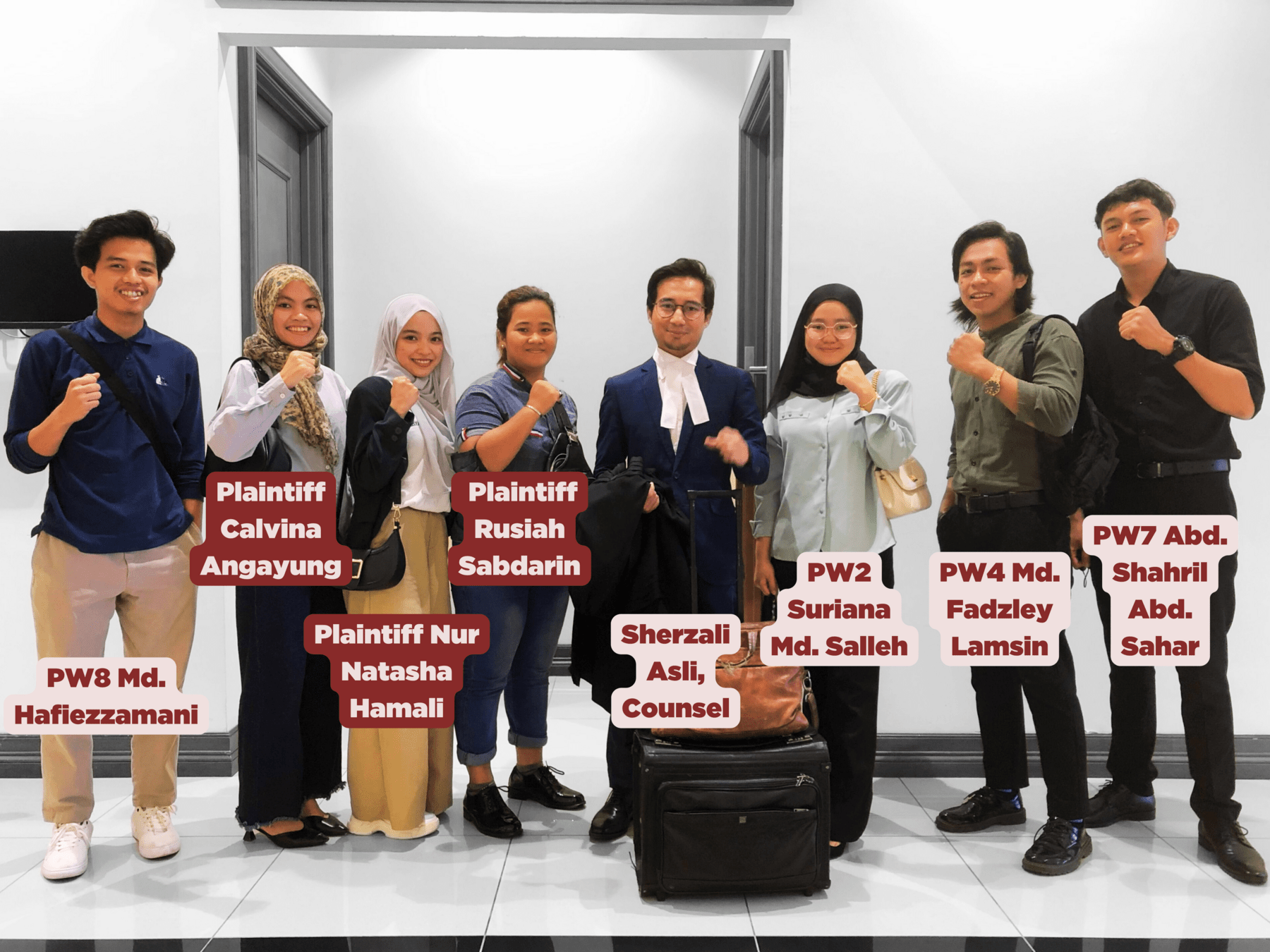
THE HIGH COURT JUDGMENT
18 July 2023
Honourable High Court Judge Justice Leonard David Shim
Rusiah Sabdarin & Ors v. Mohd Jainal Jamran & Ors [2023] 8 CLJ 603 [HC]
Agreed Facts (AF)
March 2022
Agreed Issues to be Tried
2023
AF 1 & 2 | The Ps were registered students of SMK Taun Gusi and entered it F1 (Jan. 2014) to F5 (Dec. 2018).
AF 3 | The Ps were in Form 4 Sains Sukan (4SS) in 2017.
AF 4 | D1, D2, D3, and D4 are employees and/or servants and/or agents of D5.
AF 5 | D1 was assigned to the Ps' Form 4 Sains Sukan (4SS) in 2017 to teach English.
AF 6 | Sometime in May 2017, D2 was notified of D1's absenteeism.
Q1 | Did D1 fail to consistently teach 4 SS English in 2017 (Ps' class), thus failing to prepare the Ps for English exams?
Q2 | If Q1 is true, did D2 have notice of D1's failures?
Q3 | If Q2 is true, did D2 take reasonable disciplinary & supervisory actions against D1?
Q4 | Are D3, D4, and D5 vicariously liable for D1's & D2's failures?
Q5 | Did D3, D4, and D5 take reasonable steps to safeguard the rights of the Plaintiffs?
Q6 | Did the Ps suffer any damages due to the actions of D1, D2, D4, and D5?
Refresher on the laws & regs.

Did D1 teach the Ps' class? NO.
-
Defendants' Evidence: D1's Buku Kawalan
-
Defendants' Evidence: D1's JPNS Integrity Unit Report
-
D1's Admission: His Long Absences
-
Cikgu Nurhaizah's Secret Recordings
-
D1 Provided Leaked Questions
-
The Laws Violated by D1
The High Court on:
The Court on D1's absences & testimony
1️⃣ Ds' own evidence of 4 SS' 1st sem. buku kawalan: D1's missing signatures exactly tally with Ps' claimed D1 absences. ✅
- Further, Ds' "non-production and/or withholding" of the 2nd sem. buku kawalan was not "satisfactorily explained". Other evidence showed D1 was more absent in the 2nd sem. The Court gave Ds "sufficient time", yet Ds never produced "credible evidence" why Ds failed to tender the 2nd sem. buku kawalan. 🔥
- Thus, the Court drew an "adverse inference", e.g., the Court presumes the AGC-MOE's missing or even withheld evidence was likely damaging to the AGC-MOE's alleged Defence. 🔥
2️⃣ Ds' own evidence of the JPNS (Jabatan Pendidikan Negeri Sabah) official Integrity Unit record of D1's 4 SS absences exactly tallies with Ps' claimed D1 absences. ✅
- Ds never disputed JPNS record showing D1's absences in the Plaintiffs' class during English. 🔥
3️⃣ Under cross, D1 finally admitted months of absences in 4 SS, exactly tallying with Ps' claims. Thus, D1 contradicted his sworn EIC. ✅
- "The court have observed D1’s demeanour" when testifying and "does not find him to be a credible witness". 🔥
- D1 claimed any possible absences were excused "school activities", but D1 gave "no evidence to show that D1 was on leave or involved in other school activities during the long period of his absence." 🔥
4️⃣PW10 Cikgu Nurhaizah's secret 4 SS recordings during D1's English periods exactly tallied with Ps' claims of D1 absences ✅.
- As Ketua Panitia Bahasa Inggeris, PW10 had already once reported D1's absences, but D2 refused to act on her report. 🔥
- PW10 provided additional make-up classes to D1's victims. 🔥
- Ds never challenged PW10's 4 SS video evidence nor additional classes for 4 SS statement. 🔥
5️⃣ D1 leaked the English exam questions to Ps' class; this conclusion is supported by D1's admission, D1's inability to rebut video & documentary evidence showing the leaked English exam questions, and the AGC-MOE's failure to object to that evidence. 🔥
- D1's "unprofessional conduct" & "breach of confidential information" rendered "the sanctity of the examination meaningless" and "gives an unfair advantage" to some. ✅
- D1 did so "in order to boost the passing rate of his students to make up for his absenteeism and / or breach of statutory duty." ✅
- PW6 and PW2 placed the 4 SS buku kawalan and leaked exam questions on DW3's desk. Neither D1, D2, nor DW3 refuted this in any testimony. ✅
6️⃣ In conclusion,
- "D1 breached regs. 3A(1) of PODCR."
- "D1 is liable to disciplinary action under regs. 3A(2) of PODCR."
- "D1 breached regs. 23 & 24 of PODCR."
- "D1 breached s. 19 of the Education Act."

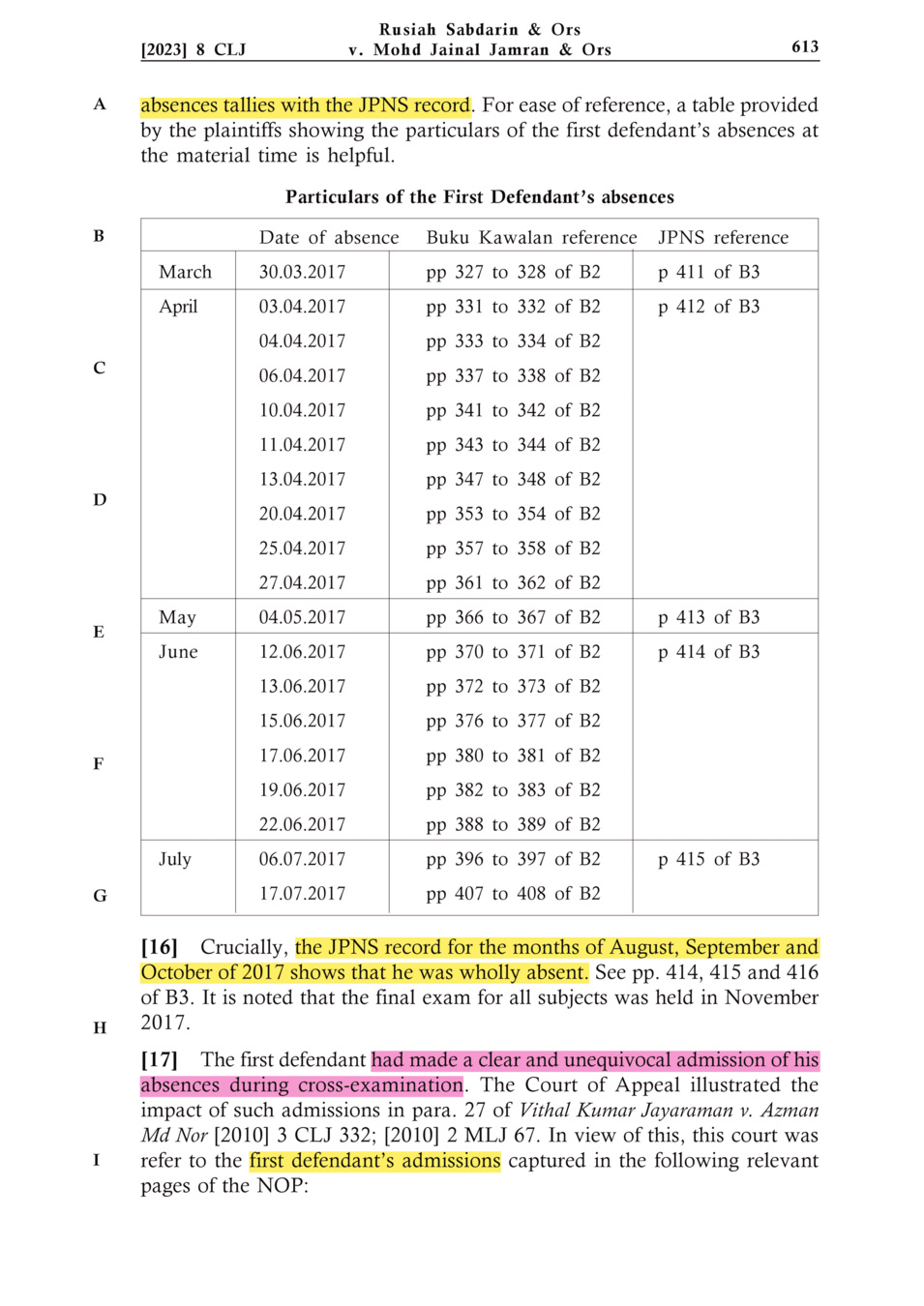
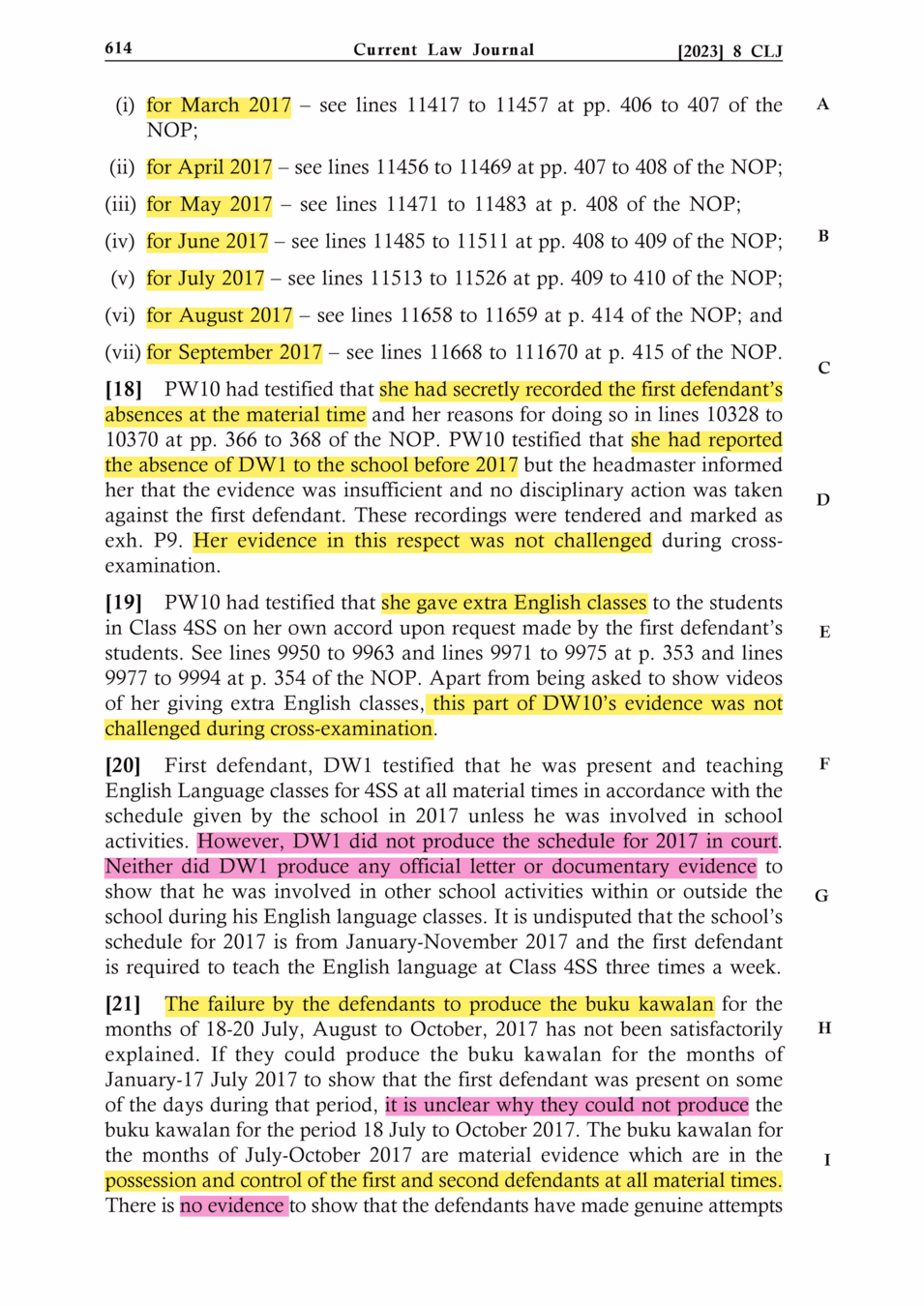
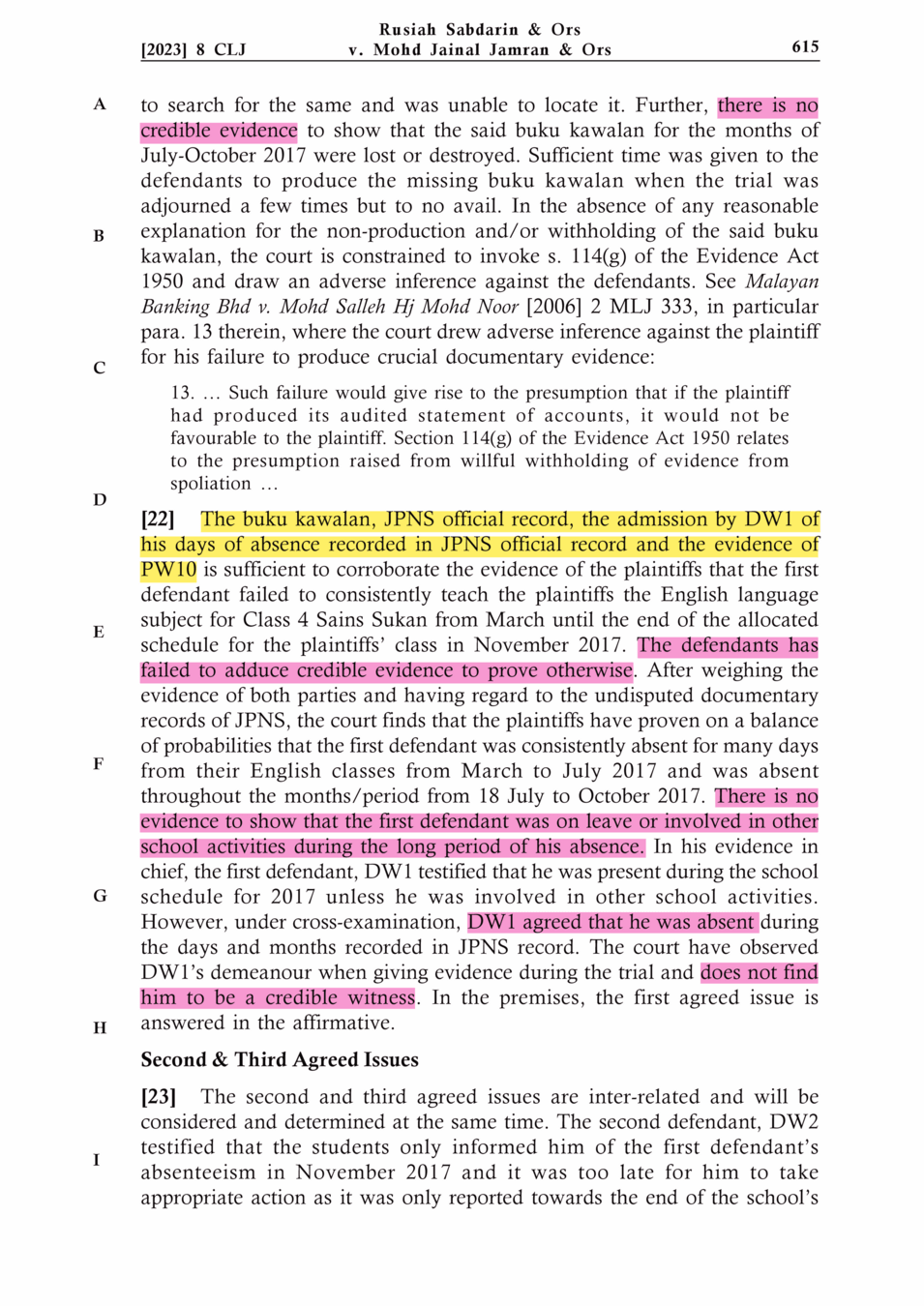
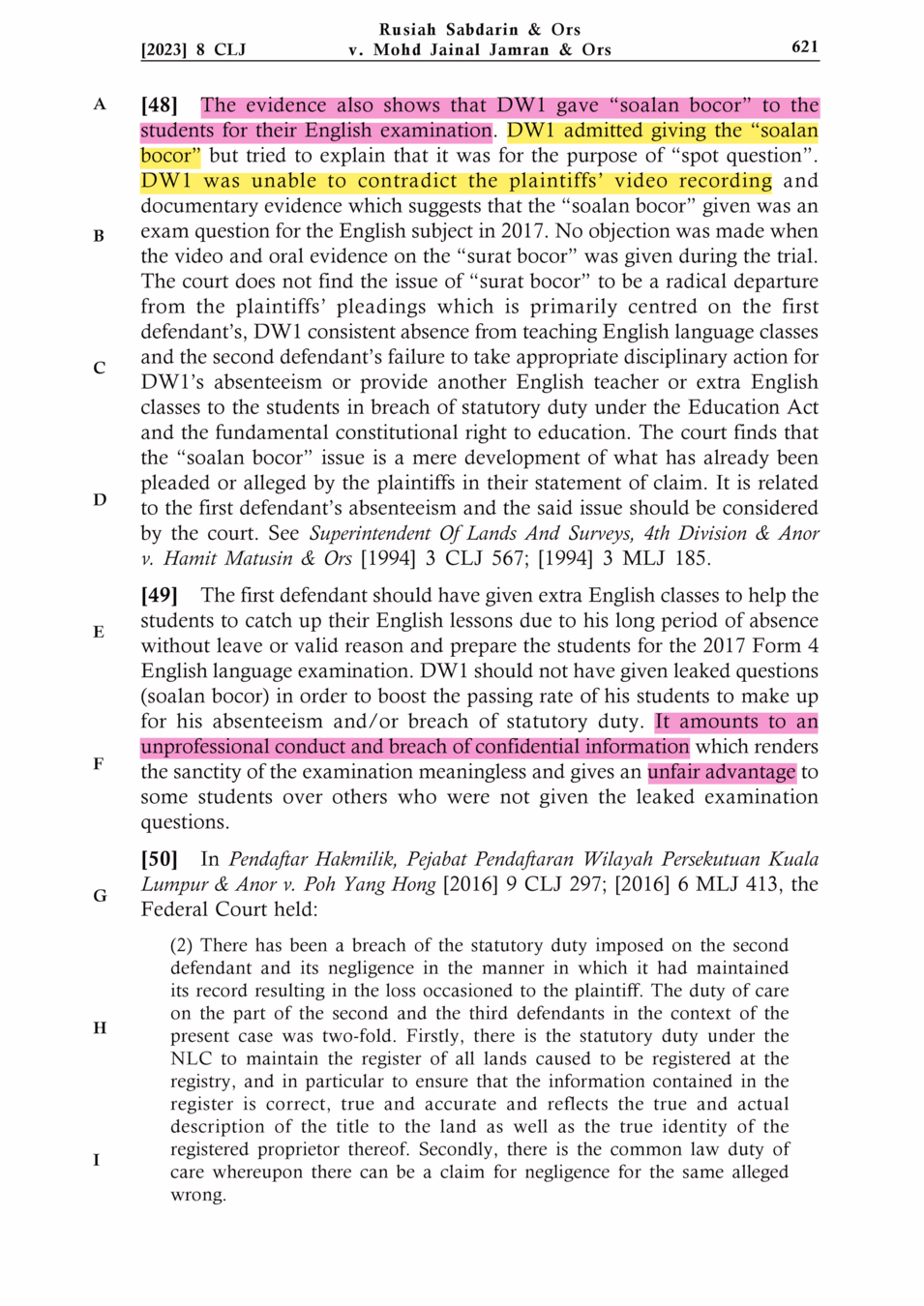
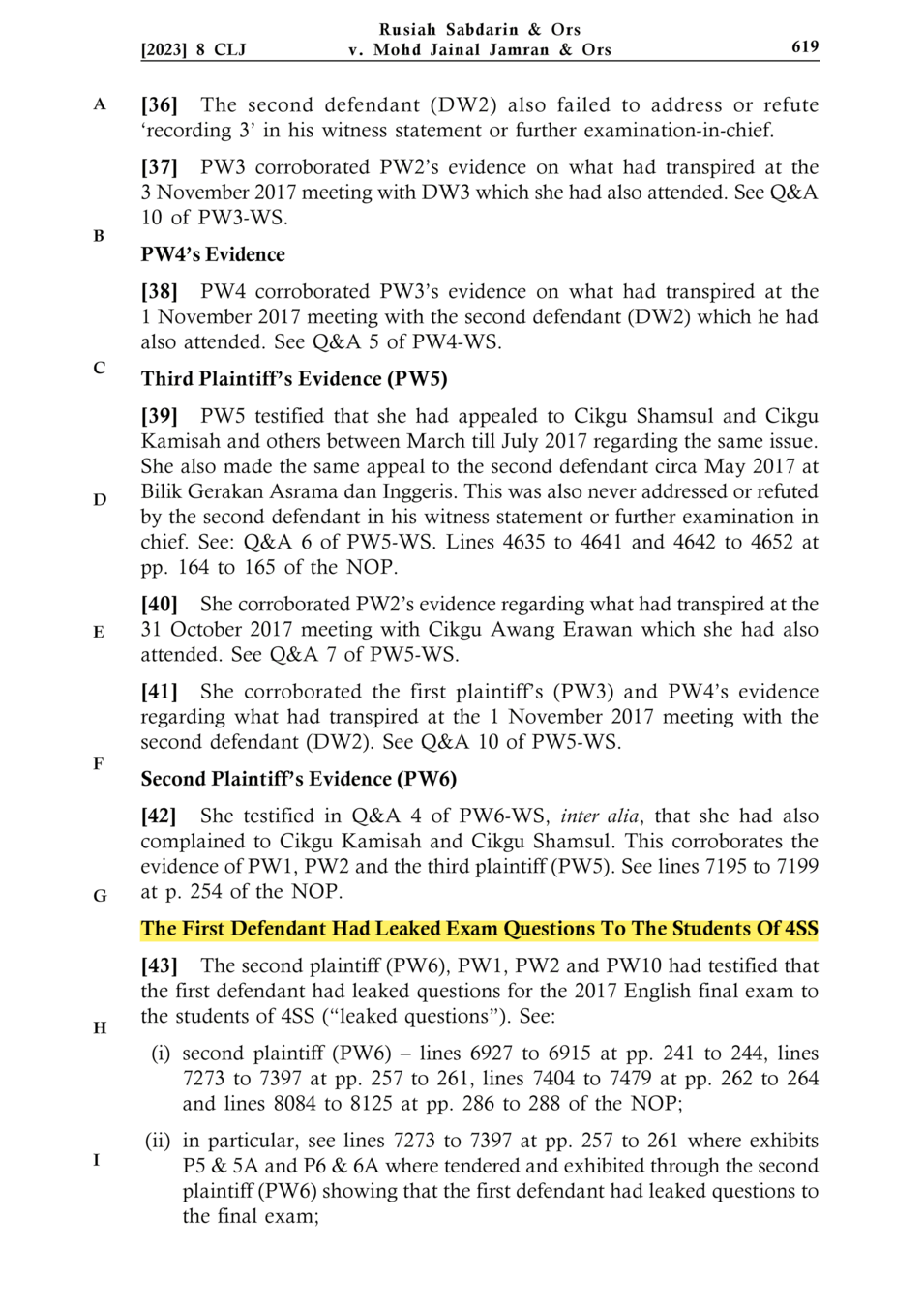
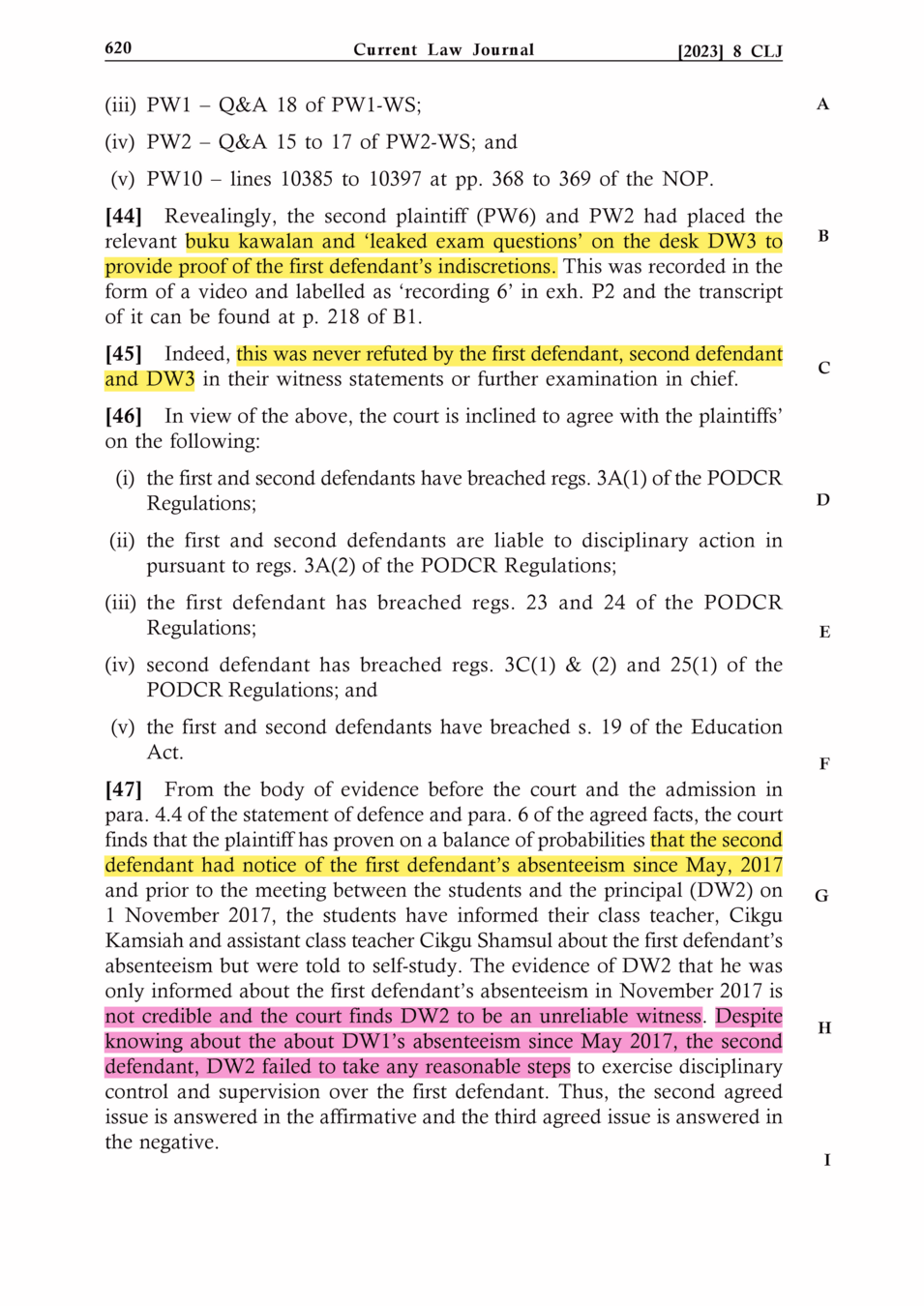

Are D2, D3, D4, & D5 also liable for D1 (absent teachers)? YES.
The High Court on:
| D1 | MOHD JAINAL BIN JAMRAN (TEACHER) |
| D2 | HJ. SUID BIN HJ. HANAPI (PRINCIPAL) |
| D3 | DIRECTOR-GENERAL OF EDUCATION |
| D4 | MINISTER OF EDUCATION MALAYSIA |
| D5 | GOVERNMENT OF MALAYSIA |
-
D2 Repeatedly Changed When He Was Informed
-
D2 Informed of D1's misconduct Twice
-
D2 Informed of D1's misconduct Thrice
-
D2 Informed of D1's misconduct Four Times
-
D2 Informed of D1's misconduct Five Times
-
D2 Informed of D1's misconduct Six Times
-
Liability of D3 / D4 against D1 & D2
-
Vicarious Liability Against D5
-
If the Defendants Took Reasonable Steps
-
If the Defendants Violated the Constitution
The Court on D2's notice & testimony
- D2 is Suid Hanapi, the "Pengetua Cemerlang" of SMK Taun Gusi in 2017. All school teachers and administrators are under his direct supervision.
1️⃣ D2 flip-flopped on when he learned of D1's absences. Ds' Defence and Agreed Facts claimed D2 was notified of D1's absences in May 2017. But during trial, D2 claimed he only learned of it in November 2017. The Court concluded "Ds are bound by their own pleadings" and the "unexplained departure…appears to be an afterthought." 🔥
- Ps and Ps' witnesses notified D2 officers Cikgu Kamisah (class teacher 4SS) and Cikgu Shamsul (assistant class teacher 4SS) of D1's absences, but "instead of taking action", they responded that "they do not want to get involved" & "ignore[d] D1's transgressions." 🔥
- PW1, PW2, and others had informed D2 officer PK1 Johari Hajat of D1's absences. On 2 Nov. 2017, D2 officer PK1 Johari had admitted even more. The Court quoted him: "Johari: 'JJ itu sebenarnya lama sudah perangai dia memang begitu' ." 🔥
- PW1 successfully explained under cross why different students calculated D1's absences differently in this recording. ✅
- PW2 and PW5 had informed D2 officer Ketua Panitia Bahasa Inggeris (KP BI) Awang Erawan of D1's absences. On 31 Oct. 2017, D2 officer KP BI Awang had admitted even more. The Court quoted him: "Awang Erawan: 'Bukan pertama kali tapi lebih baik kita tidak, sebab saya tidak mahu kamu membuat sesuatu tanggapan. Buat masa ini kalau boleh saya pun tak nak dia dikenakan tindakan disiplin dan sebagainya tetapi dia harus sedar bahawa apa yang dia buat sekarang dia adalah tak sepatutnya.' " 🔥
- DW3 Norhana "failed to address or refute" this recording in any testimony, whereby "this further confirms the school administration ...failed to act against D1." ✅
- PW6, PW1, PW2, and PW10 all stated D1 had leaked the exam questions to the 4 SS class. Further, PW6 and PW2 placed the 4 SS buku kawalan and leaked exam questions on DW3's desk. Neither D1, D2, nor DW3 refuted this in any testimony. ✅
The Court on D2's notice & testimony
- PW5 had informed D2 of D1's absences in May 2017. 🔥
-
- D2 "never addressed [n]or refuted" this mid-year notice by PW5 in any testimony. ✅
- PW3, PW4, PW5, and others had informed D2 again of D1's absences on 1 Nov. 2017. 🔥
The Court on D2's notice & testimony
- The Court concluded from the Ps' & Ds' Agreed Facts, Ds' evidence, Ds' testimony, Ps' testimony, and Ps' evidence that "D2 had notice of D1's absences since May 2017". 🔥
- Further, the Ps had also notified D2's officers, yet were rebuffed with orders to "self-study". 🔥 Despite knowing since May 2017, "D2 failed to take any reasonable steps to exercise disciplinary control & supervision over D1." ✅
- D2's testimony where he claimed he was first informed of D1's absences in Nov. 2017 is "not credible and the Court finds DW2 to be an unreliable witness." 🔥
The Court on D3 and D4 re: D1 and D2
- D3 is the Director-General of the Ministry of Education and D4 is the Minister of Ministry of Education. Under s. 19 of the Education Act, D2, D3, & D4 had a statutory duty to prepare the Ps for English exams. Thus, D2, D3, & D4 "must ensure" the teacher provided to Ps are "reasonably competent" and "present in class". 🔥
- Jabatan Pendidikan Negeri Sabah (JPNS) is under the "purview and jurisdiction" of D3 and D4. The Ds "tendered the JPNS record" and "these records prove D1's absences at the material time." 🔥
- "This means that JPNS, and by extension D3 and D4, were aware or ought to have known about D1's transgressions." ✅
- As D1 was absent, D2, D3, and D4 had "a statutory duty to take appropriate disciplinary action" against D1. ✅
- Again, as Ds themselves tendered the damning JPNS record, D3 & D4 "were aware or ought to have known" of D1's absences. ✅
- As D2 refused to act vs. D1, D3 and D4 also had a "a statutory duty to take appropriate disciplinary action" against D2. ✅
The Court on D3 and D4 re: D1 and D2
- D2 could've taken appropriate disciplinary action vs D1. D2 did not.
- D2 could've provided another English teacher for Ps. D2 did not.
- D2 could've provided additional English classes for Ps. D2 did not.
- The Ps' hardship, losses, and / or emotional injury—caused by 1) D1's absences and 2) D2's, D3's, and D4's lack of supervision and disciplinary action—was "reasonably foreseeable" by the Ds.
- Thus, the Ds also had a "common law duty of care". Ds are then "liable for breach of statutory duty and negligence". ✅
- However, the Court does not find Ds acted with "targeted malice" nor an intended "reckless indifference" towards the Ps, thus Ds' misfeasance in public office cannot be established.
The Court on D5 re: vicarious liability
- D5 is the Federal Government of Malaysia. It is "undisputed" D1, D2, D3, and D4 are "employees or servants or agents" of D5. 🔥
-
D3 and D4 "were aware or ought to have known" because they tendered the damning JPNS record. Thus, D3, D4, and D5 are held "vicariously liable" for the acts and omissions of D1 and D2. 🔥
- The Court rejected the AGC-MOE's claim that D3, D4, and D5 are not liable by ss. 5 and 6 of the Government Proceedings Act (GPA) 1996. These state tort claims against the Government require the Government officer responsible to also be made a Defendant. In this case, Government officers D1 and D2 were Defendants as well as the D3, D4, and D5 (Government). Thus, the GPA ss. 5 and 6. are "no longer a relevant consideration...."
The Court if Ds took reasonable steps
- "In light of the...above...the Court does not find that D1 to D5 took any reasonable steps to safeguard the rights of the Plaintiffs." 🔥
The Court if Ds violated the Constitution
- Guided by multiple authorities, the Court "'adopt[s] a prismatic approach'" so articles 5 and 12 of the Federal Constitution are "'read together'" "'as broadly as possible'" with "'a generous and liberal interpretation'". 🔥
- Thus, the constitutional right to education under article 5 & 12 is clarified as including the right to be provided a teacher:
- who enters class; and
- who teaches class; and
- who prepares their pupils for examinations.
- The Ds have thus breached the Constitution. 🔥

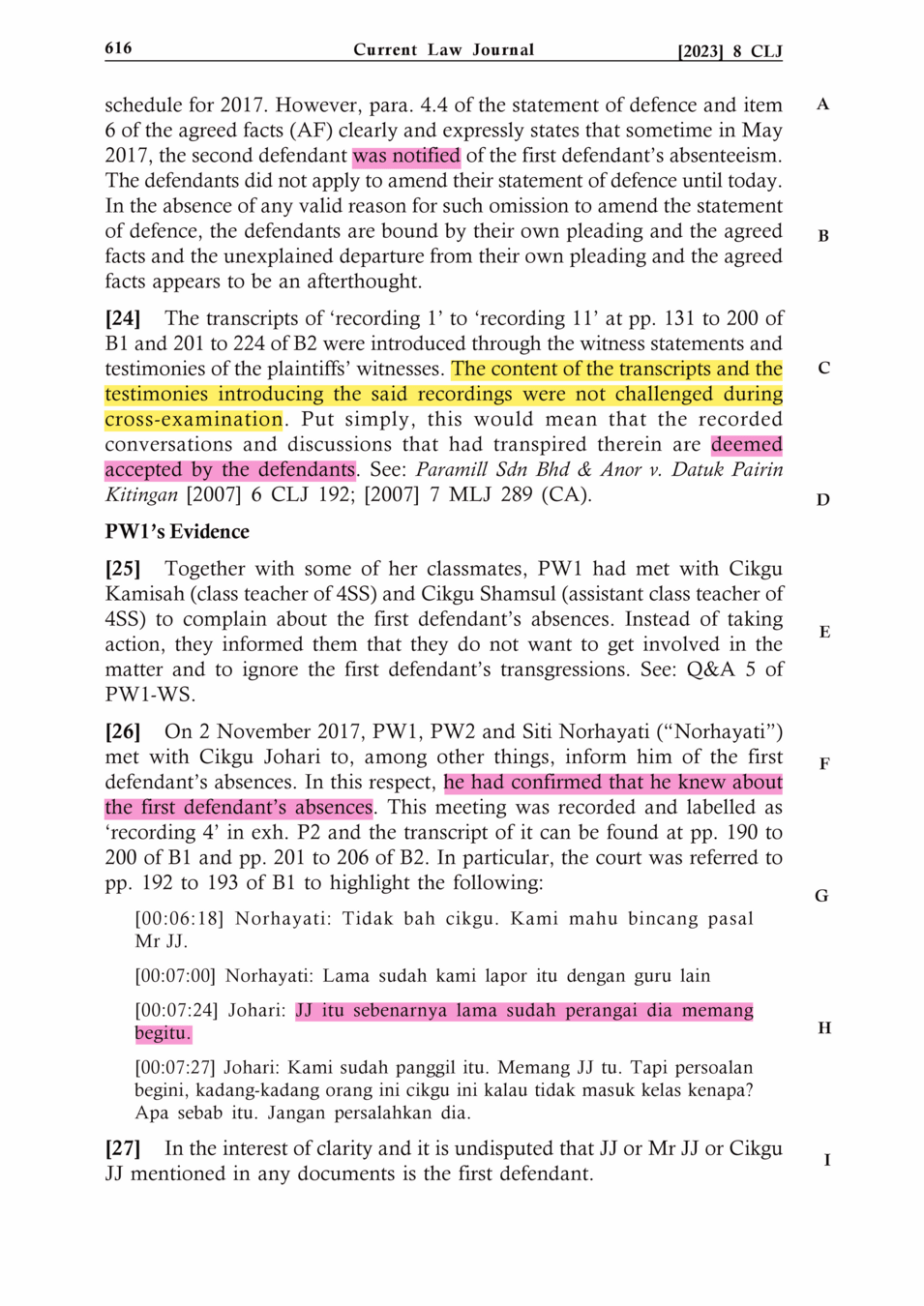
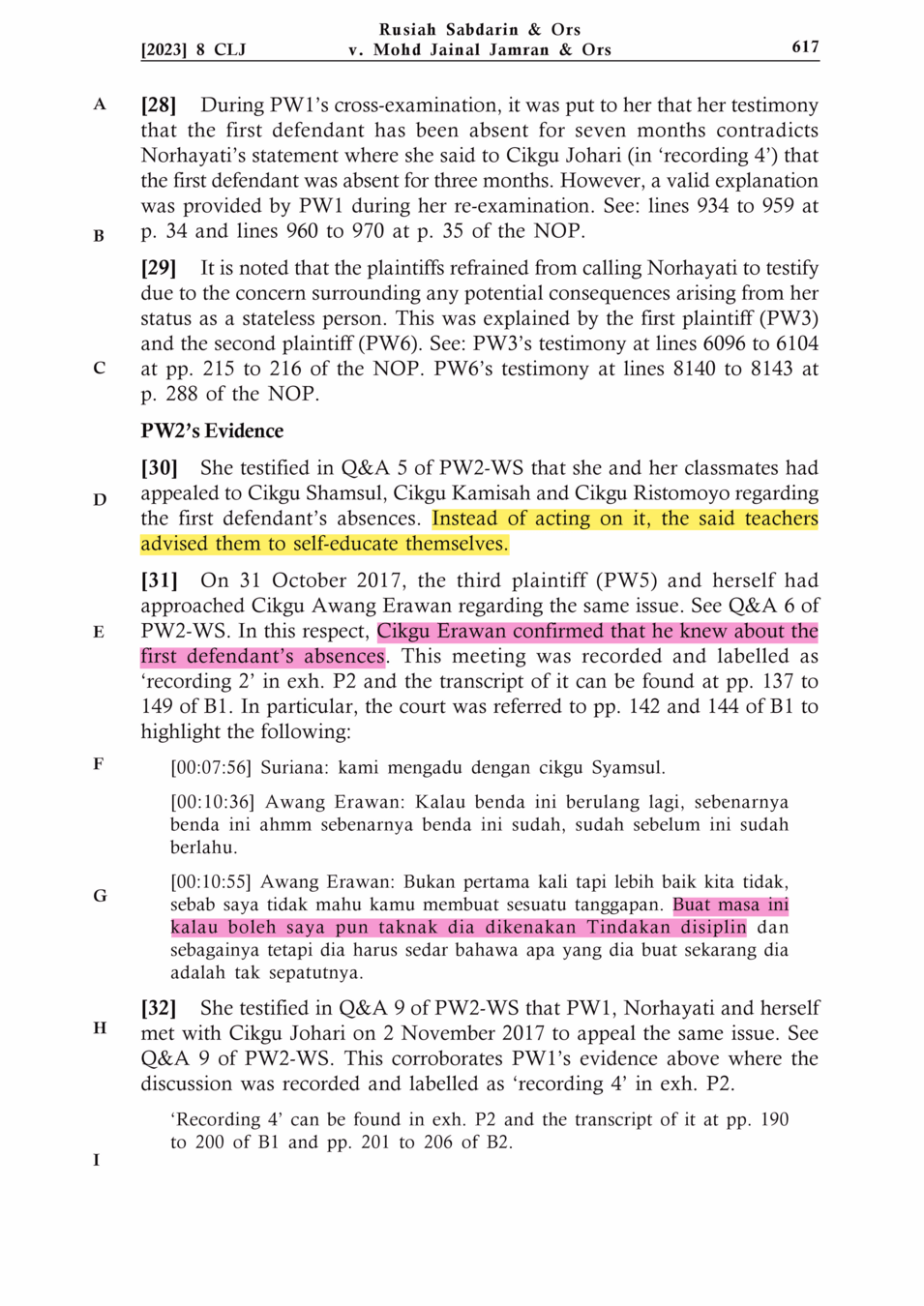
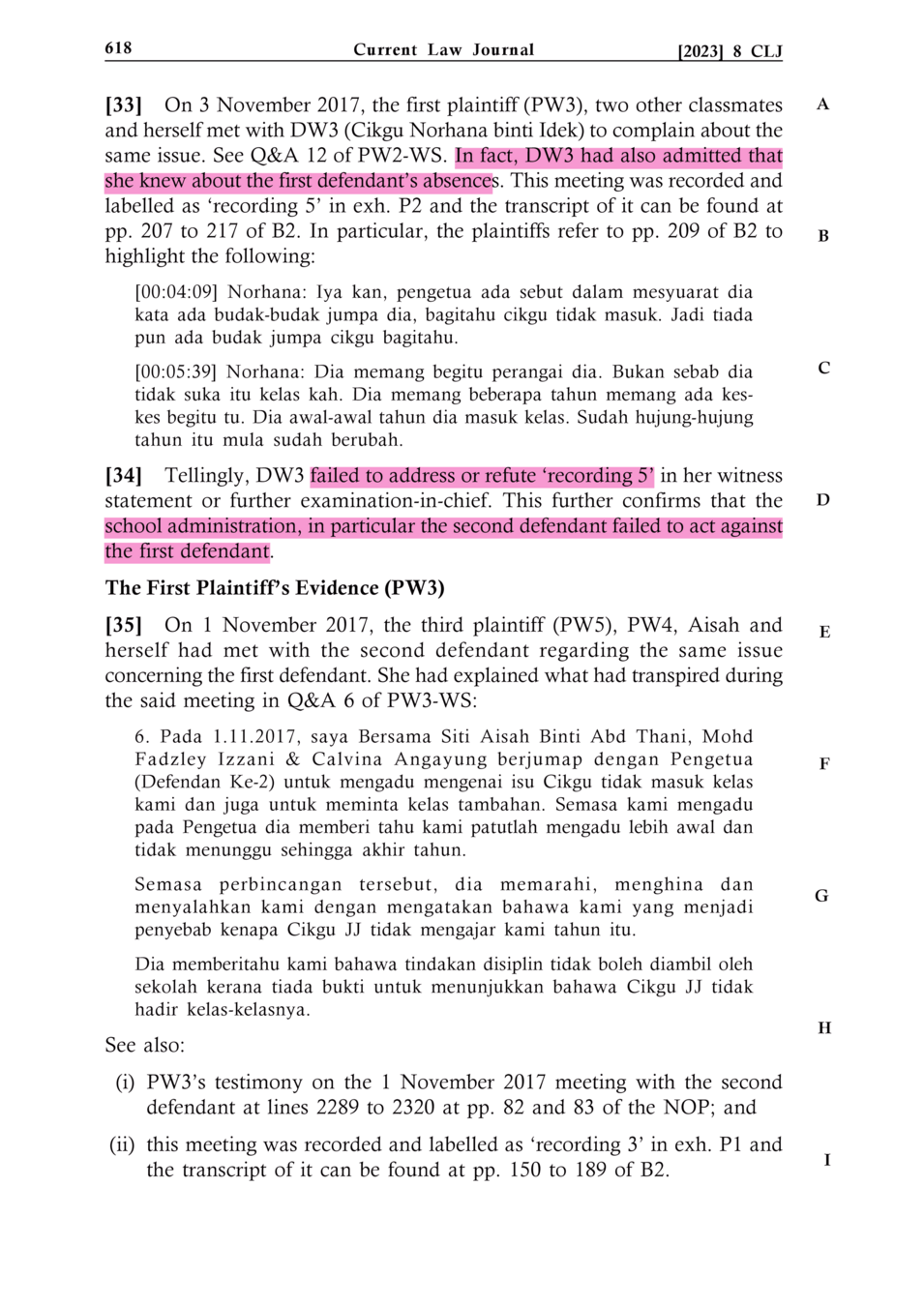



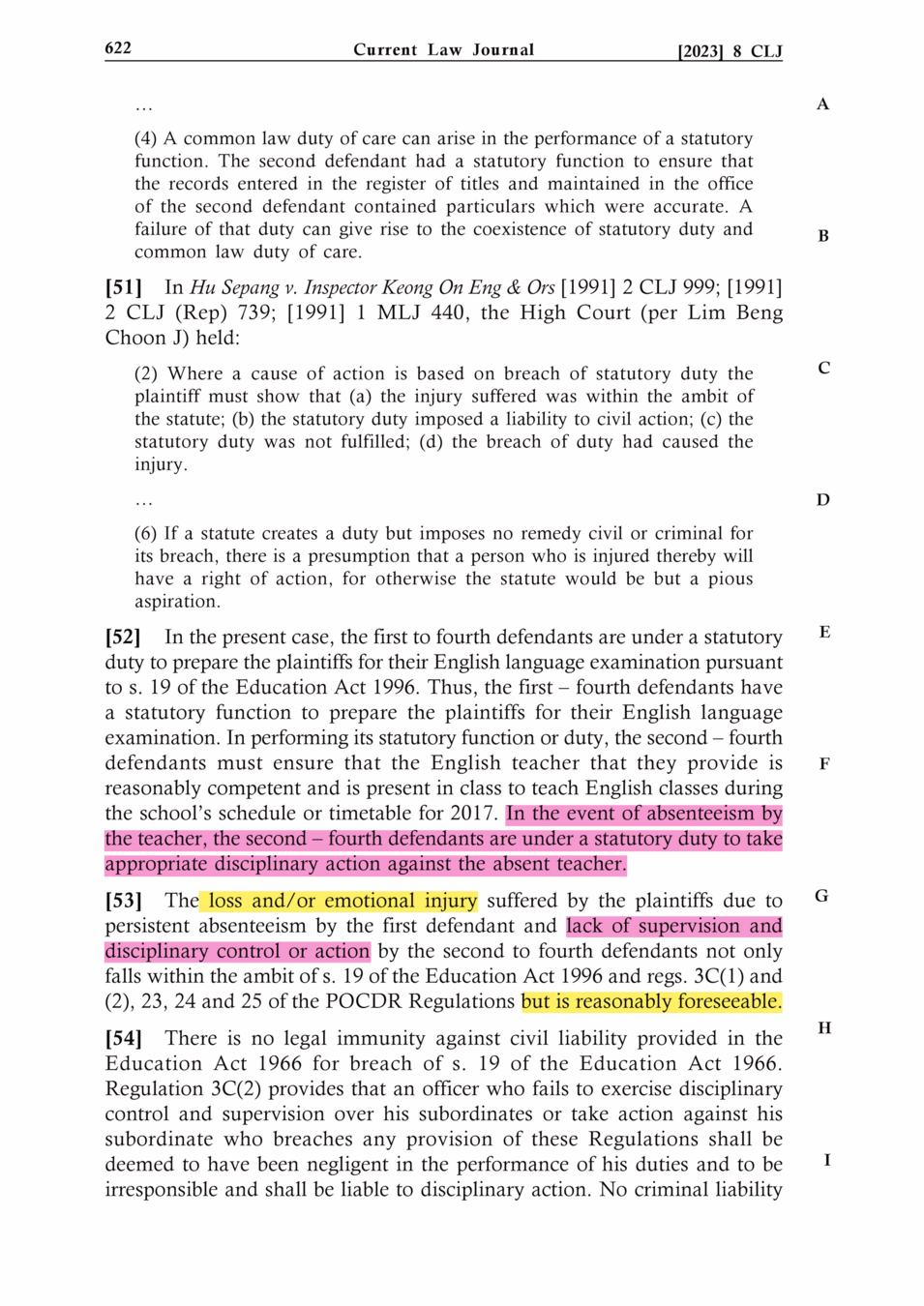
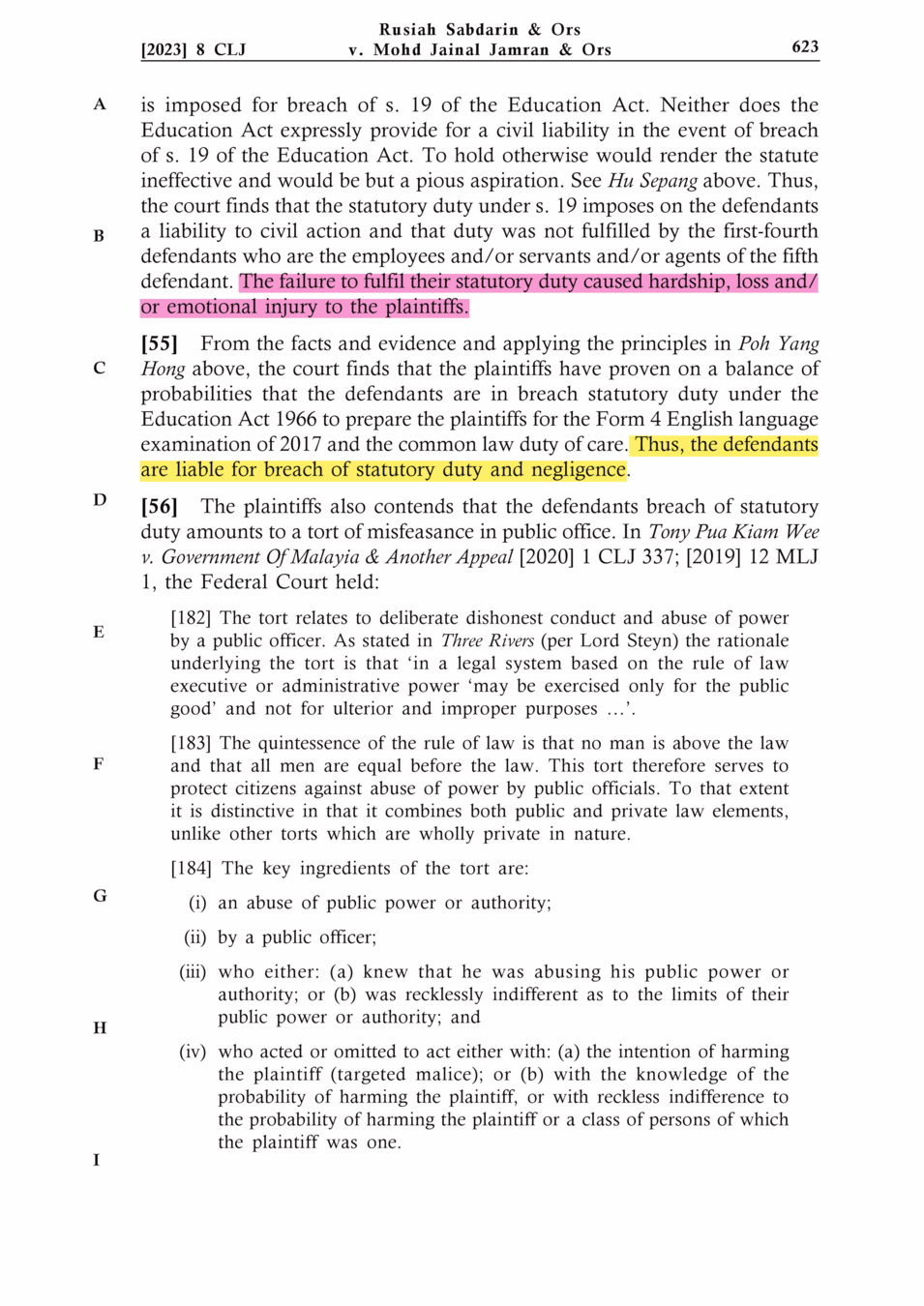

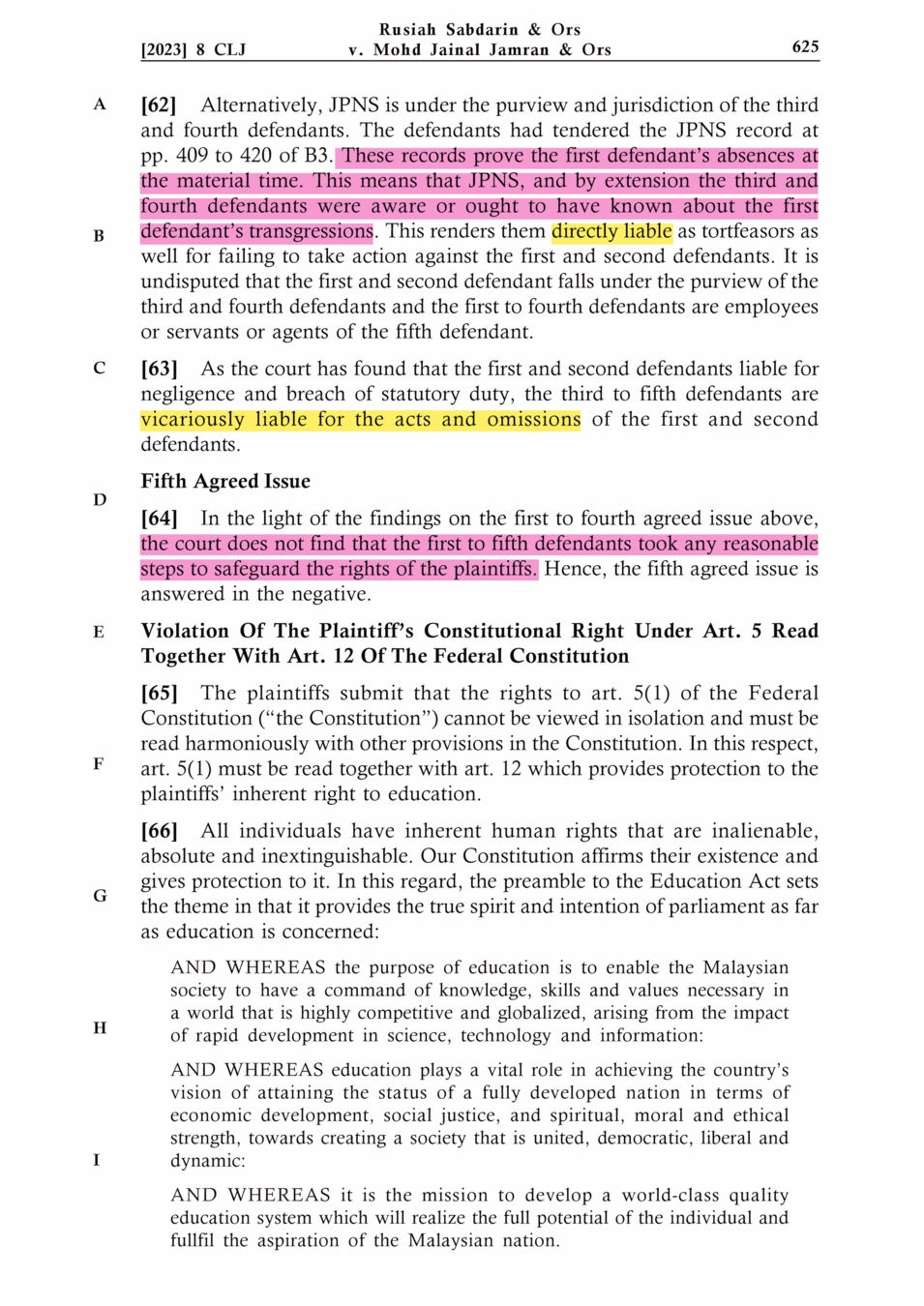
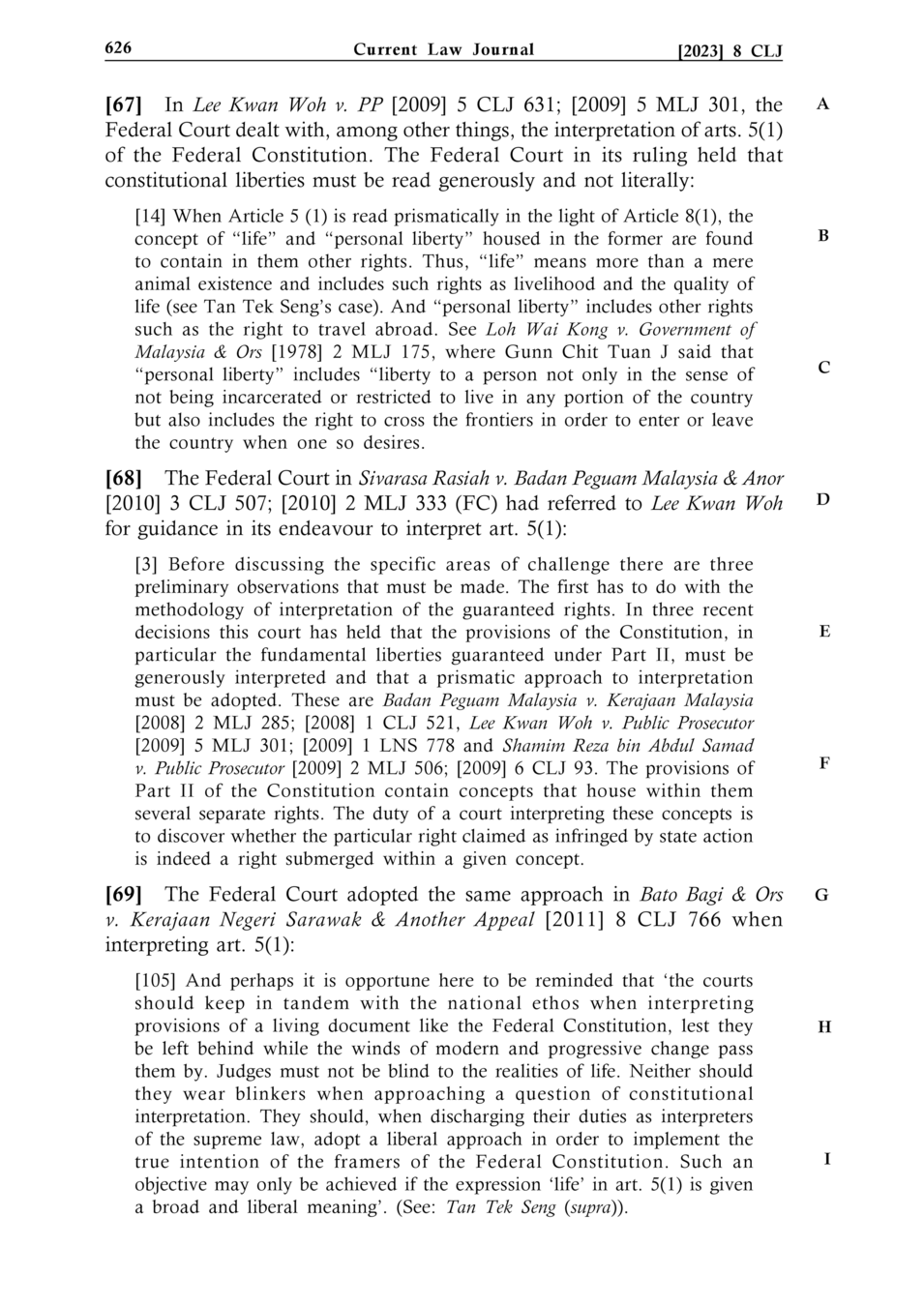
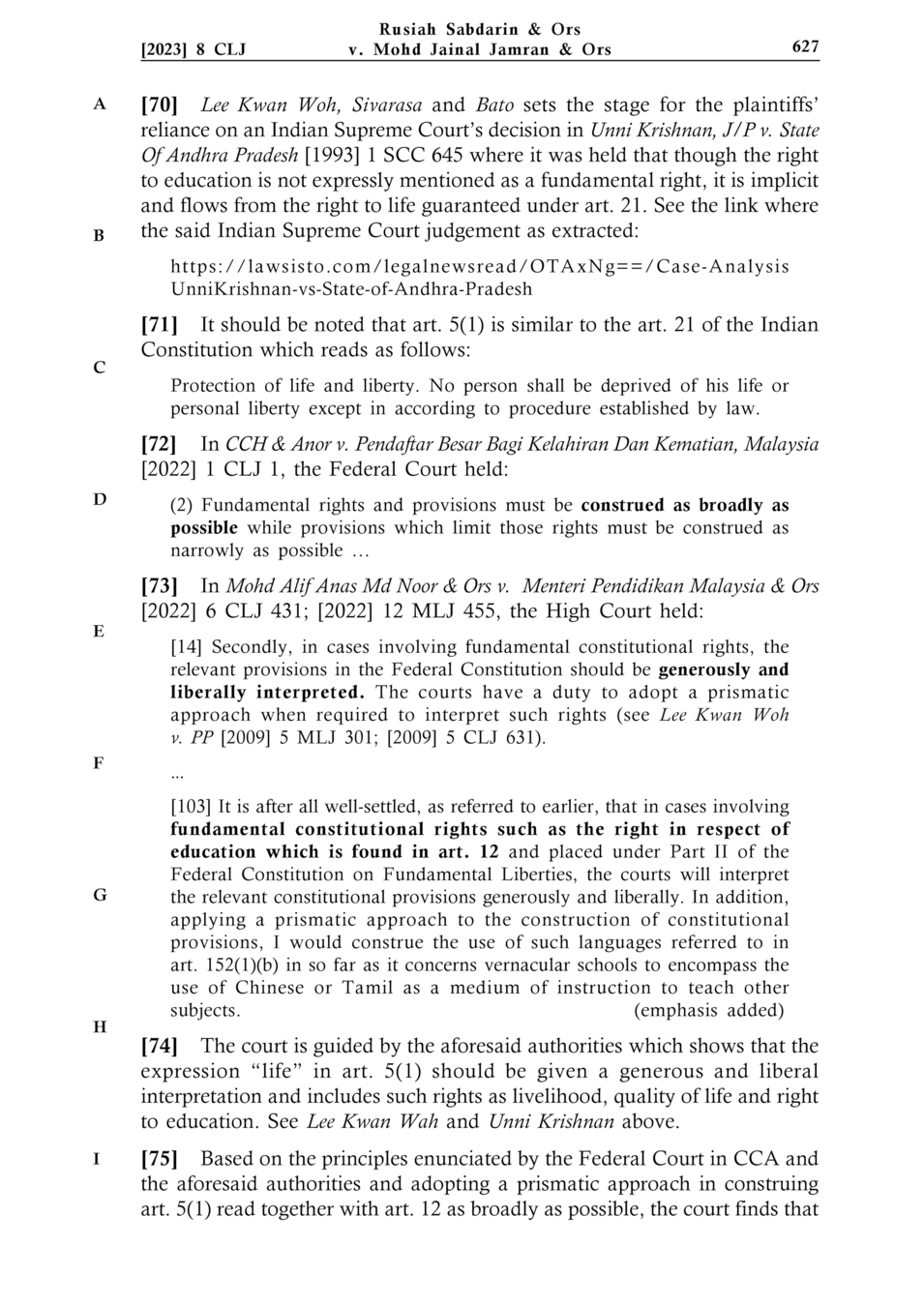
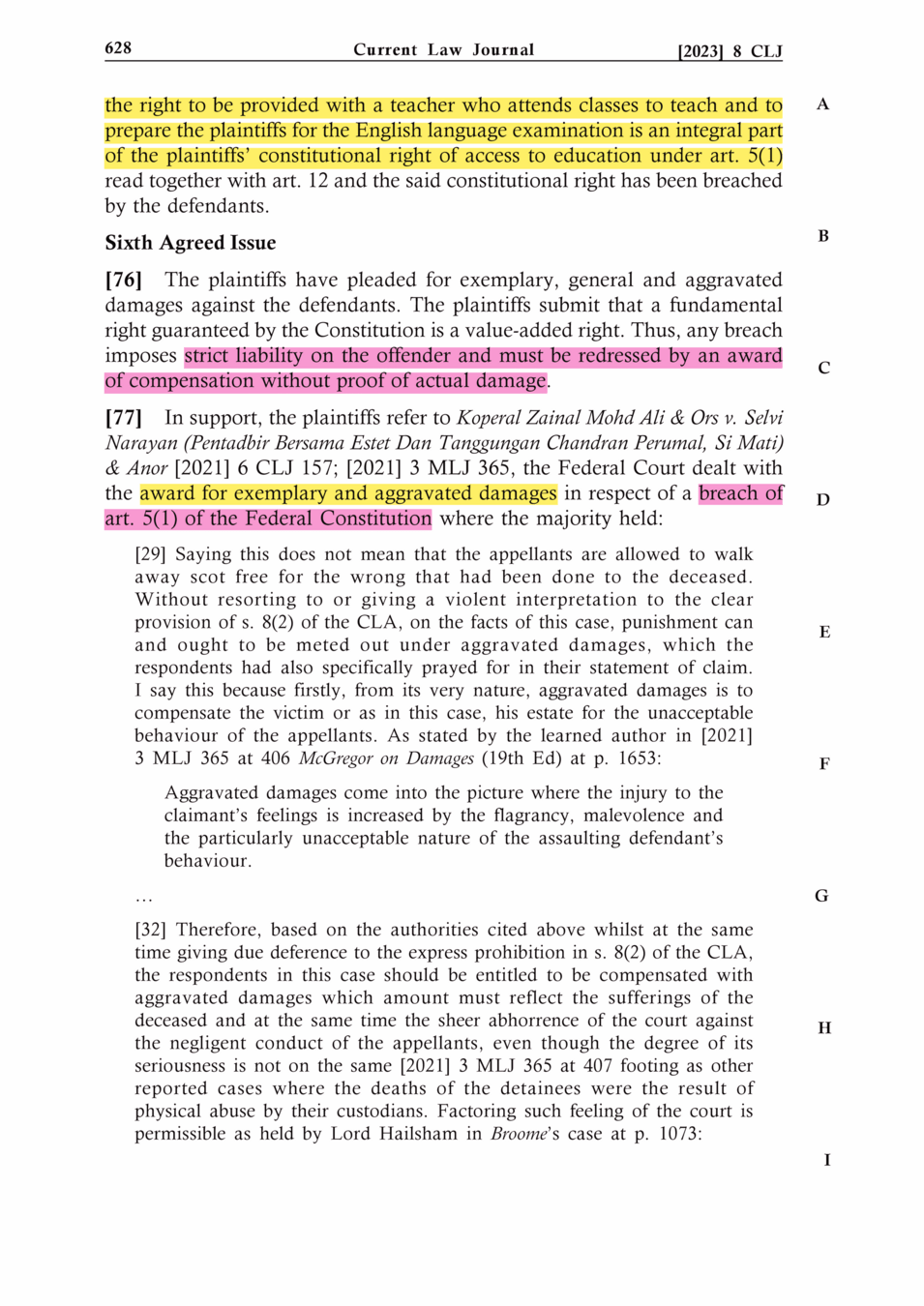
The High Court caught the AGC-MOE red-handed
AGC-MOE knew for years Ps' claims vs D1's 2017 4 SS absenteeism were true
The Judgment repeatedly cited one piece of the Ds' own evidence against them: the "JPNS official record" actually proved the Ps' claims.
-
Who created it? Who tendered it to Court?
- Agency: Jabatan Pendidikan Negeri Sabah (JPNS) / Sabah State Education Department | Unit: Integrity | Authenticity: Integrity Unit stamp on all pages
- Who tendered it: the Defendants, in their Evidence Bundle
-
What was its purpose? What did it say?
- What was its purpose: A day-by-day analysis of D1's attendance in the Ps' 2017 Form 4 SS class.
- What did it say: On most days, D1 was absent. The Court said this record "clearly shows that D1 was partially and/or wholly absent from his English classes from March to October 2017."
-
When did it analyse D1? When was it submitted to Court?
- Dates analysed: January 2017 to December 2017
- Date submitted: October 2021 in the Ds' Evidence Bundle
-
AGC-MOE knew for years Ps' claims vs D1 were true
-
AGC-MOE humiliated & victim-blamed Ps during trial
-
AGC-MOE's flip-flops in trial vs. filings, missing evidence
-
AGC-MOE paid damages for their litigation conduct
Table of Contents
STAGE 1: VICTIMS, CIKGU NURHAIZAH, & D1 KNOW D1 WAS LONG ABSENT IN 4SS CLASS



JAN -
DEC
2017
STAGE 2: D2 AND D2 OFFICERS AWARE D1 WAS LONG ABSENT IN 4SS CLASS & MORE



MAY -
NOV
2017
STAGE 3: AGC-MOE DEFENCE STATES THAT D1 ALWAYS ENTERED & TAUGHT 4SS CLASS



21
JUN
2021
STAGE 4: AGC-MOE EVIDENCE BUNDLE PROVES IT KNEW D1 LONG ABSENT IN 4SS CLASS



27
OCT
2021
STAGE 5: AGC-MOE TO COURT: "D1 NEVER ABSENT" AS AGC-MOE ALSO NEVER DISPUTE BUNDLE



11
APR
2023
STAGE 6: COURT SAYS DAMAGES ALSO BASED ON THE "WAY" AGC-MOE CONDUCTED CASE



18
JUL
2023
The Judgement's use of the Ds' own JPNS official record
Para. 15-16: It compared D1's absences in the 1st semester buku kawalan vs the JPNS official record: the JPNS record's absences tallied virtually perfectly.
Para. 22: It noted the Ds never disputed the JPNS official record; D1 admitted under cross that he was absent precisely when the JPNS official record stated he was absent; PW10 Cikgu Nurhaizah's video evidence of the 4SS classroom also precisely aligned with the JPNS official record.
Para. 62-63: It confirmed the MOE & Fed. Gov't are vicariously liable because the 1) JPNS official record clearly showed D1 was absent & 2) it was tendered by the Ds.
Para. 92-93: For years, the AGC-MOE disputed the truth that D1 was absent. Even after the AGC-MOE produced unequivocal evidence that D1 was absent, the AGC-MOE swore that D1 was "always present" in the Plaintiffs' class. This type of trial conduct must have consequences.





AGC-MOE humiliated & victim-blamed Ps' and Ps' witnesses during trial
After ex-students of 4 SS—from SMK Taun Gusi in one of Malaysia's ten poorest districts—testified against D1 and D2, the AGC's Senior Federal Counsel (SFC) / Federal Counsel (FC) began a line of questions.
Even as the AGC-MOE long held evidence proving Ps' claim of D1's
absences, their Officers of the Court prepared & asked trial questions that humiliated & victim-blamed these student whistleblowers in Court.
The Court stated this "appears to be an attempt to shift all blame from the absentee teacher to the students" (full quote below).
Court proceedings are public and all trial testimony is protected from legal claims of defamation. Thus, the Ps and Ps' witnesses would have no recourse against the AGC for any humiliation claims based on trial.
A public rebuke of the AGC by the Court is quite rare; this line in the final Judgment illustrates how severe the AGC's trial questioning truly was.
We surmise some conclusions not explicitly stated in the Judgement:
- A student's performance has nothing to do with an MOE officer's attendance. These two issues are unrelated.
- A student's performance in any other subject has no causal relationship with any other subject. These are unrelated.
- A student is never responsible for an MOE officer's choice to violate the law. These are unrelated.
The conclusion is clear: the AGC-MOE shifted the blame from itself & officers to the child victims & the Court did not take that lightly.

AGC-MOE's non-production of evidence & failure to amend filings
Throughout the Judgment, the High Court noted instances of the AGC-MOE first claiming an event and then providing zero evidence for that or changing their story at trial. Critically, the Judgment noted that throughout litigation, AGC-MOE's legal filings were never amended.
AGC-MOE never amended Defence to admit D1 was absent, even after Defendants' evidence showed D1 was very absent
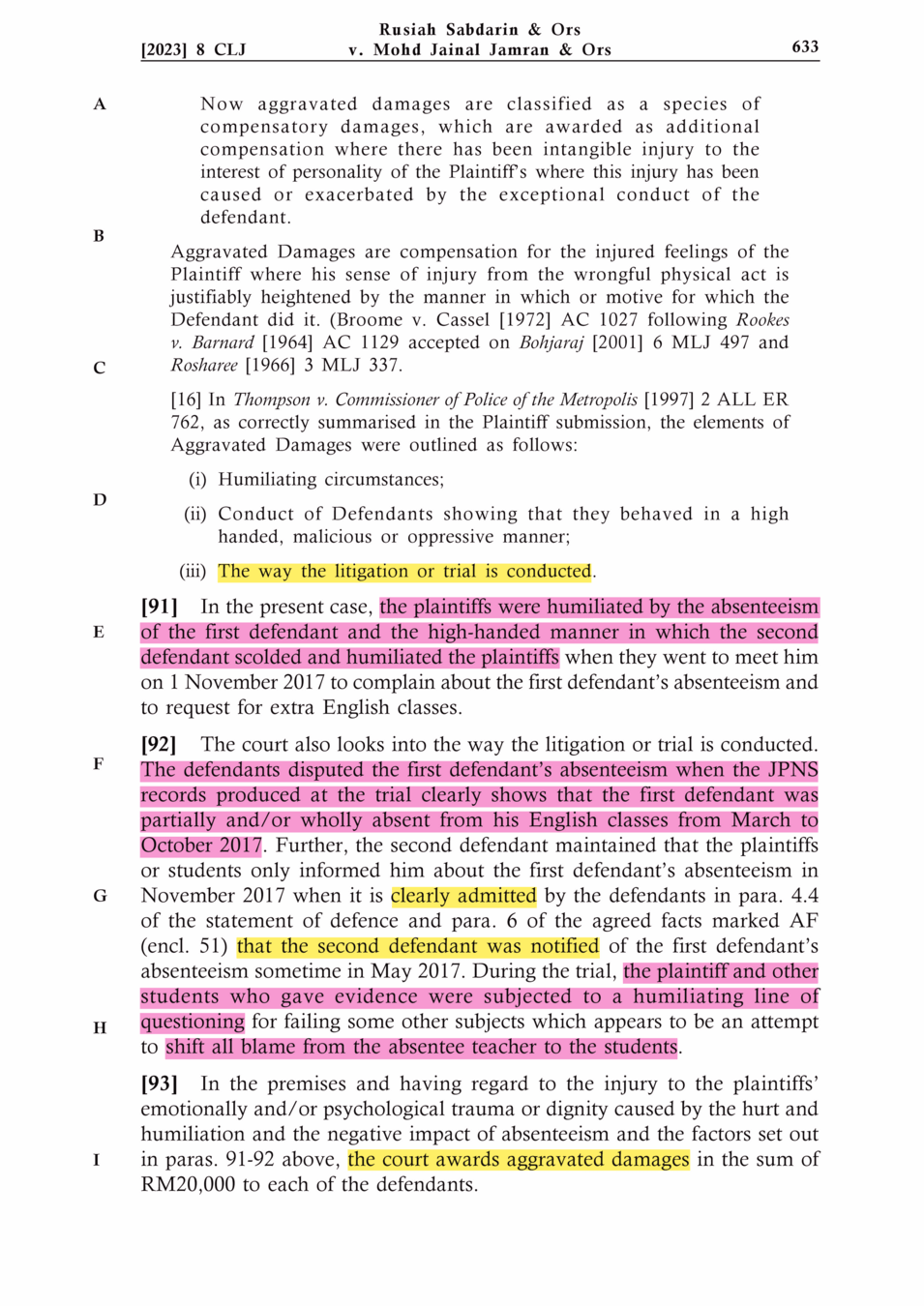
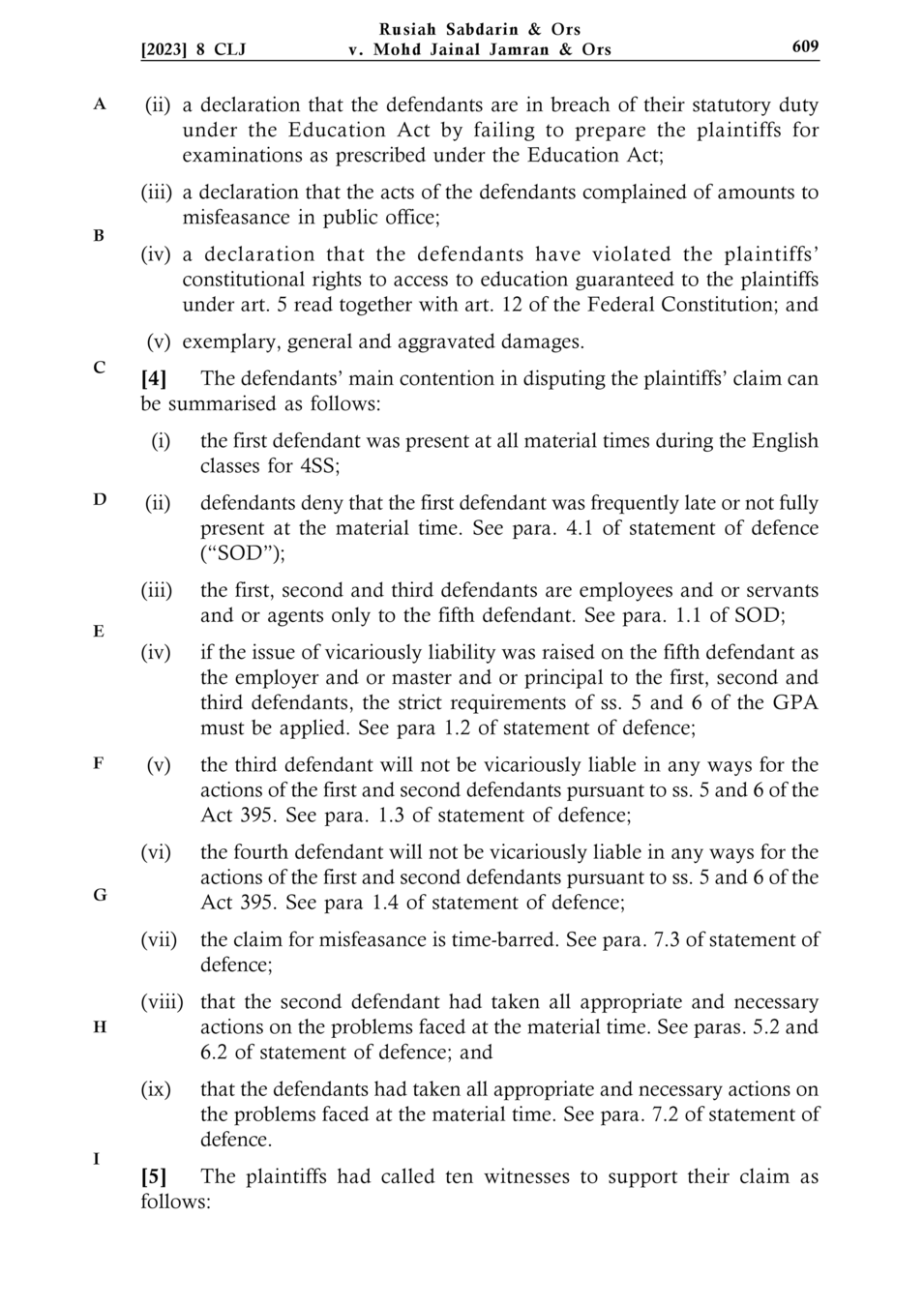

Defence claimed D1 was only absent for school activities, yet the AGC-MOE produced no evidence of such activities

In his EIC, D1 claimed he had attended Ps' class at all material times, but under cross, D1 changed to admit that he was frequently absent in Ps' class throughout 2017



In the AGC-MOE Statement of Defence & Agreed Facts, D2 admitted he knew of D1's absences since May 2017. But during his testimony, D2 suddenly changed his story that he only knew of D1's absences in November 2017




The AGC-MOE's Defence claimed D2 took all appropriate & necessary actions, yet in trial D2 admitted he took no action





The AGC-MOE failed to / refused to tender the 2nd sem. buku kawalan, even after tendering the 1st sem.


Because of the AGC-MOE's "non-production and/or withholding", the Court was "constrained to invoke s. 114(g) of the Evidence Act 1950 and draw an adverse inference against the Defendants."
AGC-MOE paid damages for their litigation & trial conduct
The Court cited a case authority that aggravated damages can stem from a counsel's "conduct" trial and litigation. Aggravated damages are unique and are not guaranteed simply by winning a case; they require injury that was "exacerbated by the exceptional conduct". Thus, the offending party's injury must be "justifiability heightened by the manner in which or motive for which" the offending party did it. Aggravated damages are usually granted in cases of physical assault, defamation, malicious prosecution, or false imprisonment.
AGC-MOE paid damages for their lawyer's litigation & trial conduct
In this case, not only were aggravated damages based on the Defendants' acts, but also on their AGC-MOE counsel's acts during litigation and trial. We remind that legal counsel are Officers of the Court: it is their duty to assist the Court to discover the facts and ensure their client is fairly treated.
Obviously, it is never a counsel's right to mislead the Court nor protect any individual from due legal consequences, even if it is their client. Here, the Court was so disturbed by "the way litigation or trial was conducted" by the AGC-MOE's counsel that they were also held responsible next to D1, D2, D3, D4, and D5 in the RM20,000 in aggravated damages granted to the Plaintiffs.

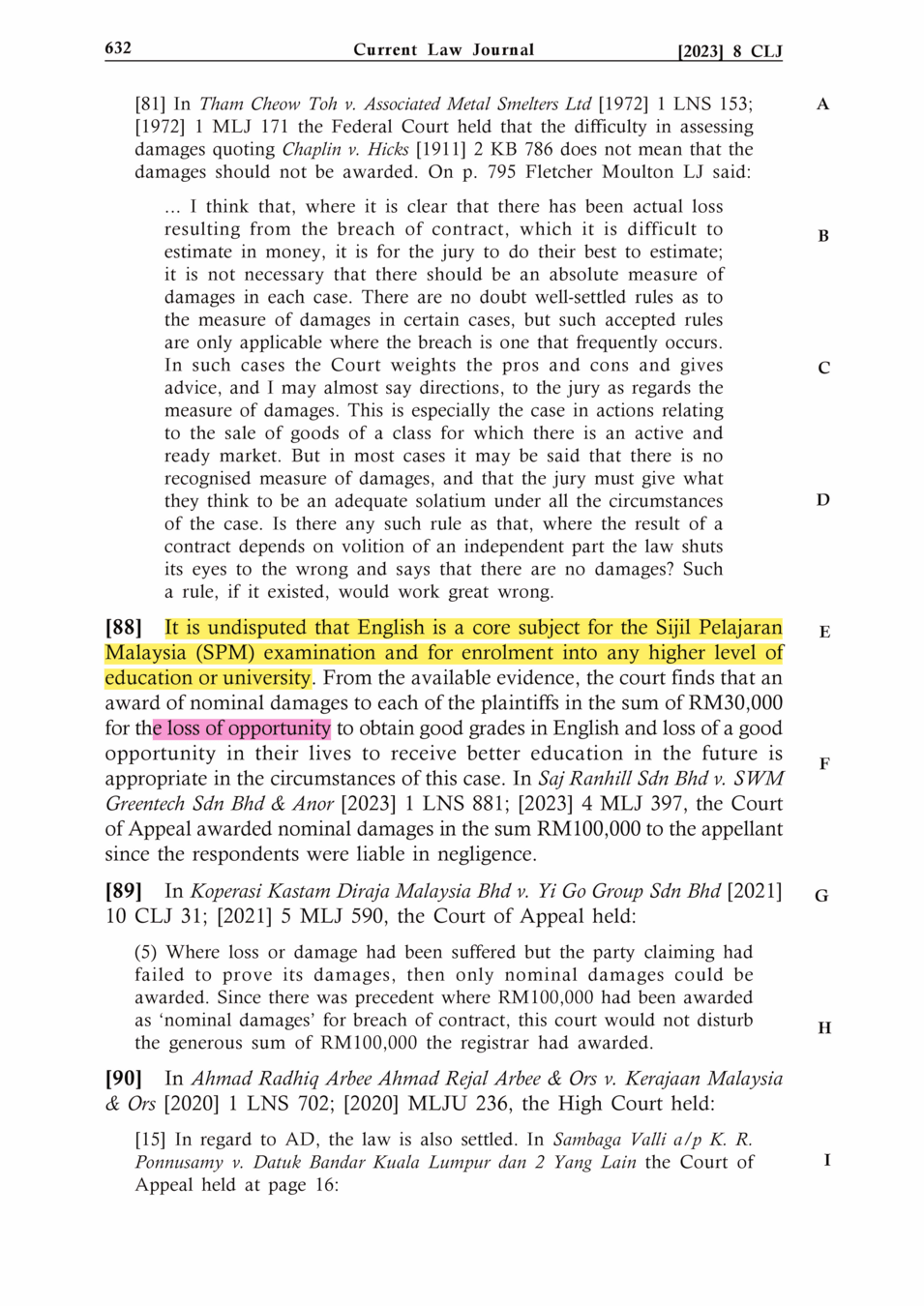


Typo Fixed
What were the High Court (HC) reliefs for the Plaintiffs?
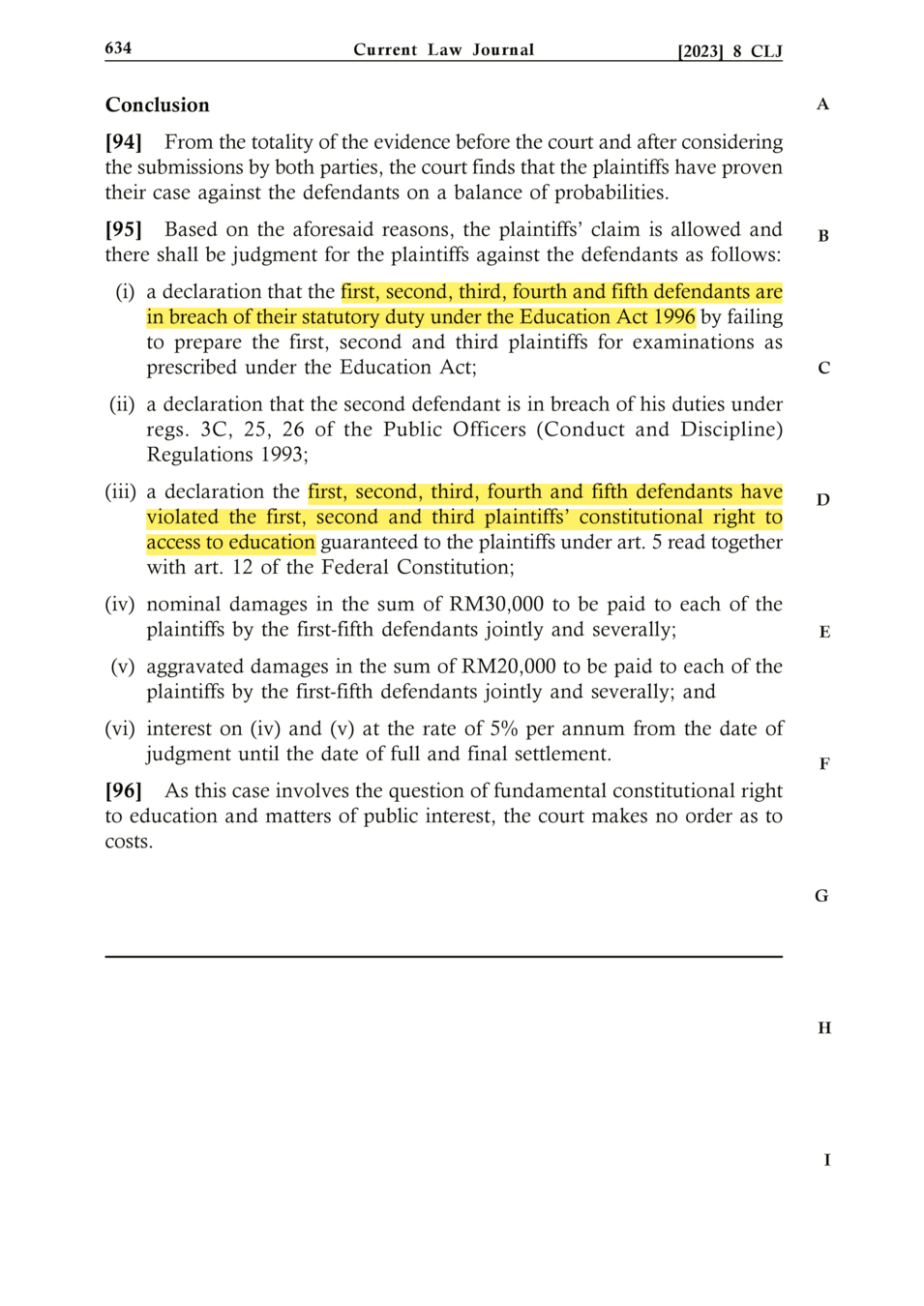
3x historic declarations
RM50,000 per Plaintiff
5% annual interest
As of 1 October 2024, the AGC-MOE have failed to comply with any High Court-ordered damages for any Plaintiff.
What declarations were made?
The Plaintiffs were granted three declarations against the Defendants' acts & omissions. These declarations confirm the MOE and its officers broke the law by refusing to teach the Plaintiffs, refusing to take disciplinary action, and further doing nothing to assist the Plaintiffs after they broke the law.
#1 | D1 to D5 breached the Education Act

Mohd. Jainal Jamran
SMK Taun Gusi teacher
Hj. Suid Hanapi
SMK Taun Gusi principal
D1
D2
Federal Government of
Malaysia
D5






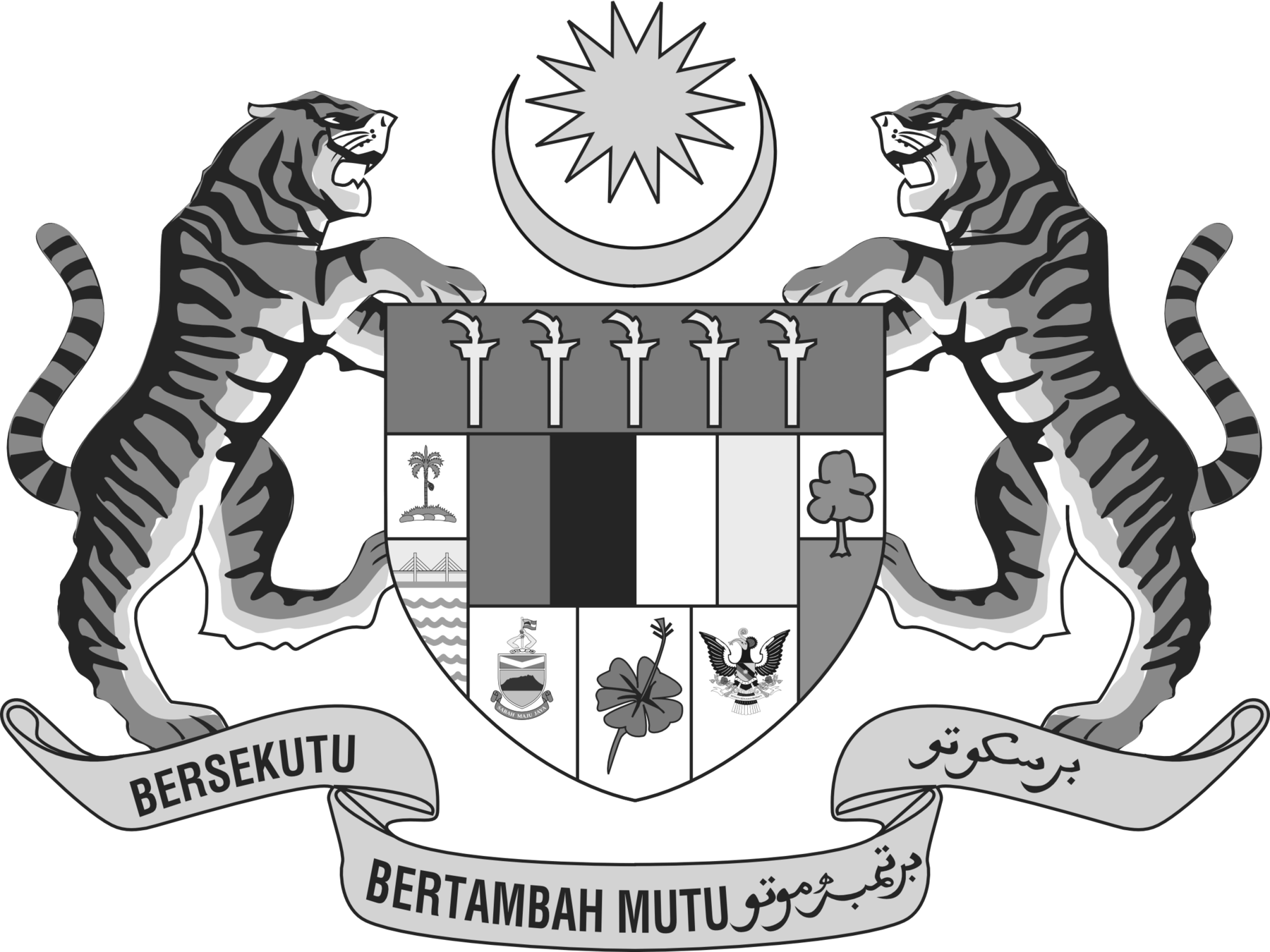
Minister of Education
YBM Radzi Jidin
YBM Fadhlina Sidek
Director General of Education
Nor Zamani Abdol Hamid
Pkharuddin Ghazali
D3
D4
#2 | D2 breached the POCDR


#3 | D1 to D5 violated Fed. Constitution
D2
Hj. Suid Hanapi
SMK Taun Gusi principal

D1
D2
D3
D4
Mohd. Jainal Jamran
SMK Taun Gusi teacher
Hj. Suid Hanapi
SMK Taun Gusi principal
Minister of Education
YBM Radzi Jidin
YBM Fadhlina Sidek






Director General of Education
Nor Zamani Abdol Hamid
Pkharuddin Ghazali
D5
Federal Government of
Malaysia

The Plaintiffs were not granted the declaration that D1 and D2 had committed misfeasance in public office.
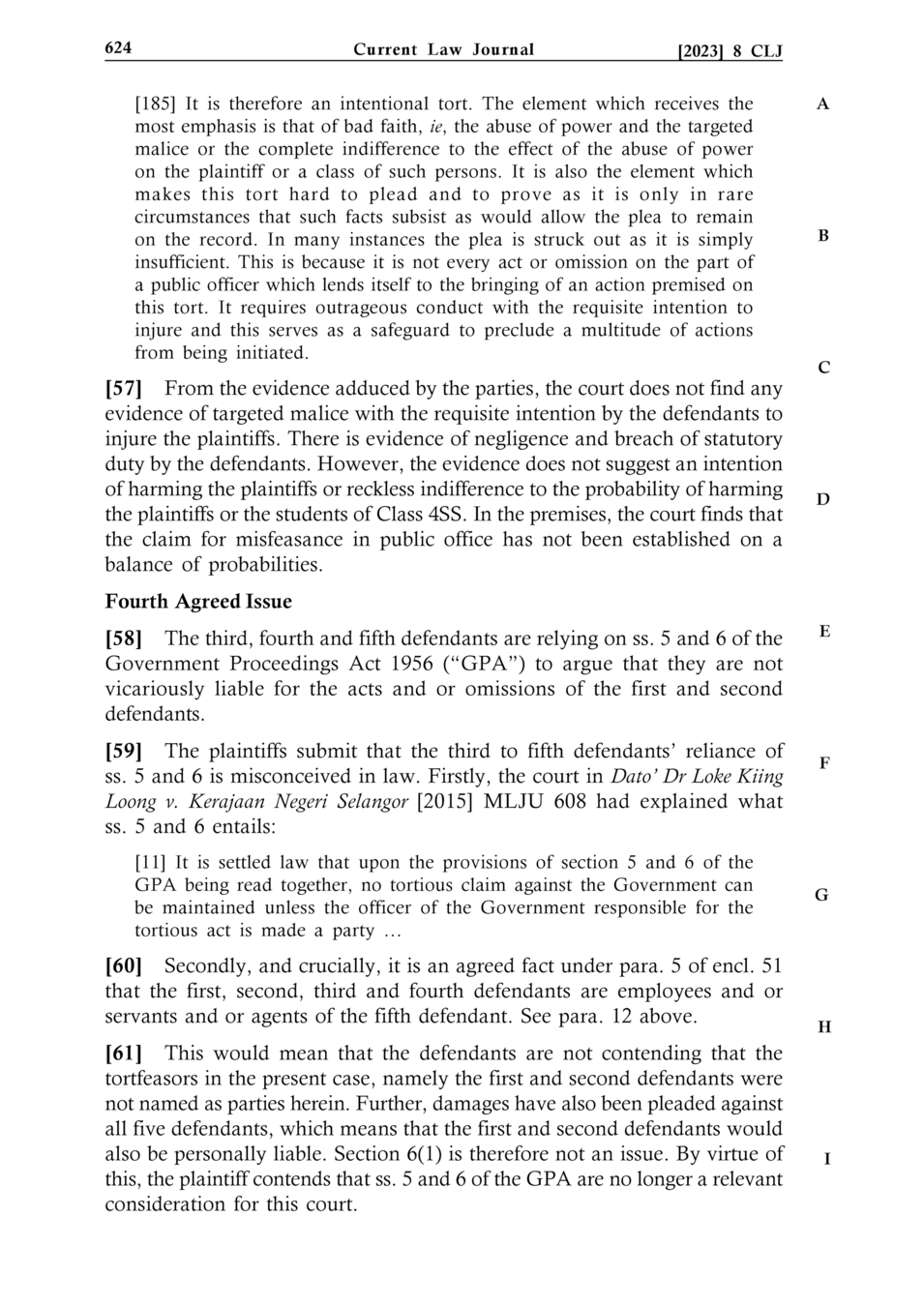
What does it mean now?
All cases of extreme teacher absenteeism in any school with:
- no replacement teacher
- no additional classes
- no disciplinary action
That absent teacher has breached the Education Act.
That school principal has breached the Education Act.
That Edu. DG & Edu. Minister have breached the Education Act.
That Federal Government has breached the Education Act.
and
That absent teacher has breached the Federal Constitution.
That school principal has breached the Federal Constitution.
That Edu. DG & Edu. Minister have breached the Federal Constitution.
That Federal Government has breached the Federal Constitution.
and
That school principal has breached the POCDR.
Unmitigated teacher absenteeism is no longer simply an internal MOE disciplinary case. It is now also a breach of the Education Act, the POCDR, & Federal Constitution.
How were damages decided?
The Plaintiffs requested three types of damages: General, Aggravated, and Exemplary Damages. Damages are first designed as compensation and based on the principle of restitutio in integrum, i.e., to make the Plaintiff whole or to put them back into their original position if they Defendants had never acted wrongly.
General Damages (RM90,000 total)
The Court found the nature of the Plaintiffs' injury was initially "difficult" to assess appropriate damages. Still, the Court concluded that damages must be awarded, citing case authority that novel cases will require estimates and are still fair.
General Damages represent losses that "cannot be precisely quantified" including pain, suffering, loss of future earnings, and other not-directly-financial losses.
The Plaintiffs tendered specific evidence & case authorities for General Damages including violations of the Federal Constitution (which do not require specific amounts to be quantified), D2's "flagrant disregard and abhorrent attitude", and PW10's recorded conversations with Cikgu Eddy regarding D2's knowledge of D1's failures, but explicit and intentional refusal to act.
The Court awarded RM30,000 to each Plaintiff (thus 3x Plaintiffs = RM90,000 total) in General Damages. It decided via five factors:
- It is undisputed that English is a core subject for the SPM.
- It is undisputed that English is a requirement for any tertiary (post-SPM) enrollment.
- It compensates the Ps' loss of good opportunity:
- to gain good grades in English exams and
- to receive better education in the future.
How were damages decided?
Aggravated Damages (RM60,000 total)
Aggravated Damages are reserved for cases when the Defendants' "reprehensible conduct" has injured the Plaintiffs' dignity or pride. It is often included in cases of physical assault, defamation, malicious prosecution, or false imprisonment. Aggravated Damages are still to compensate Plaintiffs, not to punish Defendants.
The Plaintiffs tendered specific evidence for Aggravated Damages including Dr Noor Aishah's report discussing the "'structural violence'" of the Defendants that was "'producing and perpetuating'" inequality at SMK Taun Gusi and the Malaysian education system.
The Defendants contended that "'there was never any type of injury'", there was "'no official complaint'", and the recording of the Defendants had 1) an unclear motive and 2) was only at the end of the year.
The Court awarded RM20,000 to each Plaintiff (thus 3x Plaintiffs = RM60,000 total) in Aggravated Damages. It decided via six factors:
- The Ps suffered emotional / psychological injury & trauma.
- The Ps were humiliated by the negative impact of D1's absences.
- The Ps were humiliated by D2's high-handed scolding, even when they were merely reporting D1's absences.
- The AGC-MOE first disputed D1's absences in 4 SS in 2017, when at trial their own evidence in the JPNS official record confirmed D1's absences in 4 SS in 2017.
- The AGC-MOE admitted in their Agreed Facts that D2 knew in May 2017, yet D2 in testimony disputed the Defendants' own admission.
- The AGC-MOE humiliated the Ps during trial questioning in an attempt to shift blame from the Ds to the Ps.
How were damages decided?
Exemplary Damages (RM0 total)
Exemplary Damages are to punish the Defendants and to set an example for others; it is the most extreme and most difficult to justify type damage. It requires the Defendants to have acted in an "'outrageous or insulting manner'".
Exemplary damages, in this case, would have relied on "oppressive, arbitrary, or unconstitutional action" by government servants. It includes "ultraviolent acts" and it also punishes unjust enrichment. In short, it is a deterrent and more as punishment against Defendants versus as a type of compensation for Plaintiffs directly.
The Judgment did not highlight any specific reason to allow nor disallow Exemplary Damages in this case.
The Court awarded no Exemplary Damages to any Plaintiff.
Addenda
PW10, Cikgu Nurhaizah Ejab, shared her whistleblowing led to death threats. A former student began a petition for her:
The 2018 High Court trial is still ongoing. The next trial dates are in early 2025. Cikgu Nurhaizah has testified.
The Judgment was originally released in English. It has also been published with a certified Malay translation.

